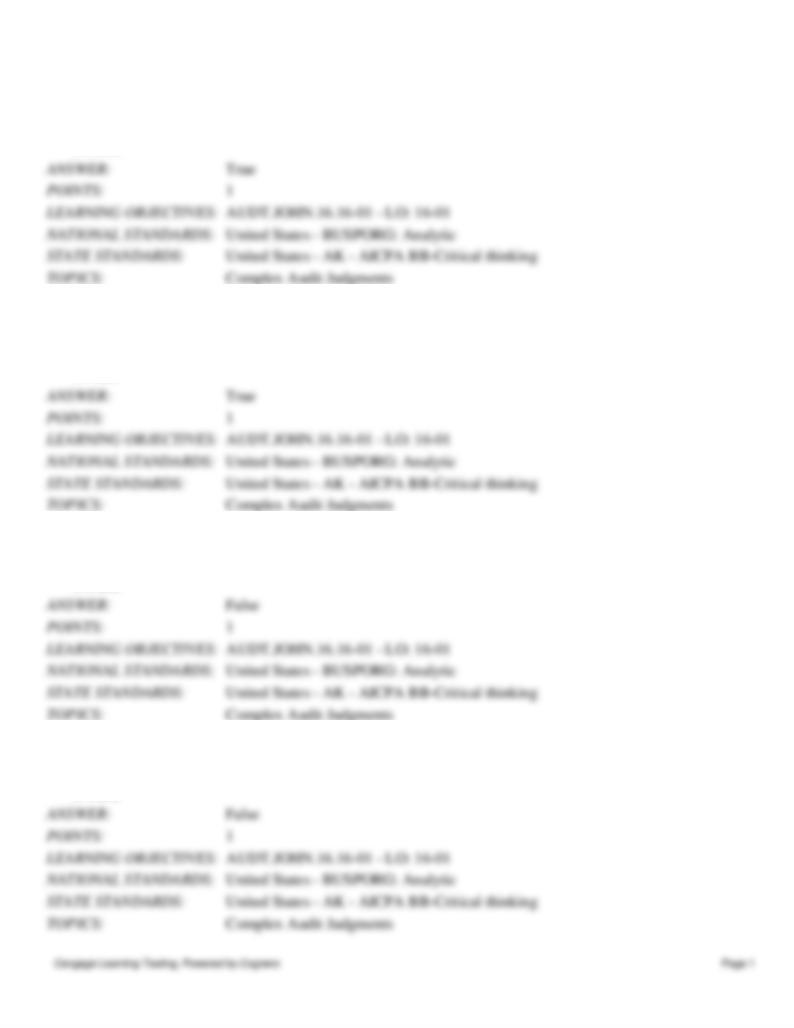
Chapter 16 - Advanced Topics Concerning Complex Auditing Judgments
1. The significant judgments of “Assets of Held-for-Sale Operations” are subject to impairment testing based on
the most likely sale or disposal price.
a.
True
b.
False
2. Complex audit judgments and decisions often involve accounts that require subjective estimates by
management.
a.
True
b.
False
3. The inventory account does not require any subjective estimates by management.
a.
True
b.
False
4. Auditors are not responsible for making judgments regarding the fair value of securities.
a.
True
b.
False
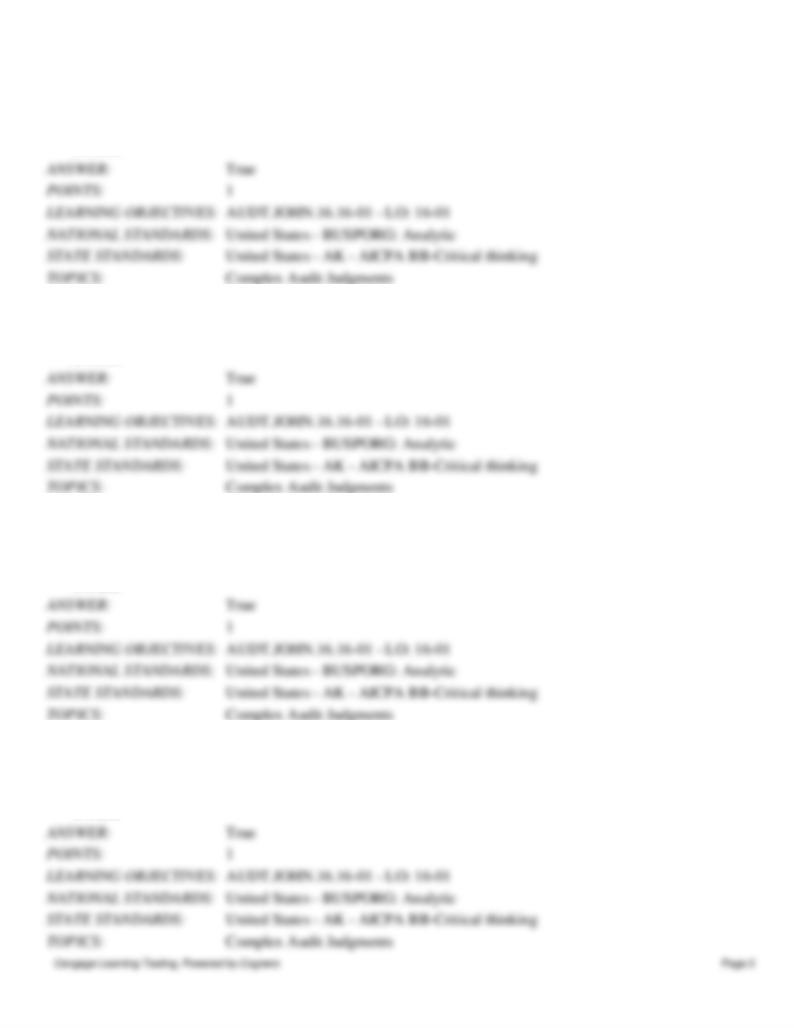
Chapter 16 - Advanced Topics Concerning Complex Auditing Judgments
5. Auditors are constantly challenged to evaluate the quality of a client’s estimates, including areas such as
obsolescence of inventory, allowance for doubtful accounts, and tax provisions among others.
a.
True
b.
False
6. Auditor needs to assess disclosures about what lines of business the company may discontinue.
a.
True
b.
False
7. There are systematic processes that the auditor can use in making most of the complex judgments in the
financial statements.
a.
True
b.
False
8. The significant judgments related to “net finance receivables” include assessing the allowance for
noncollectibility.
a.
True
b.
False
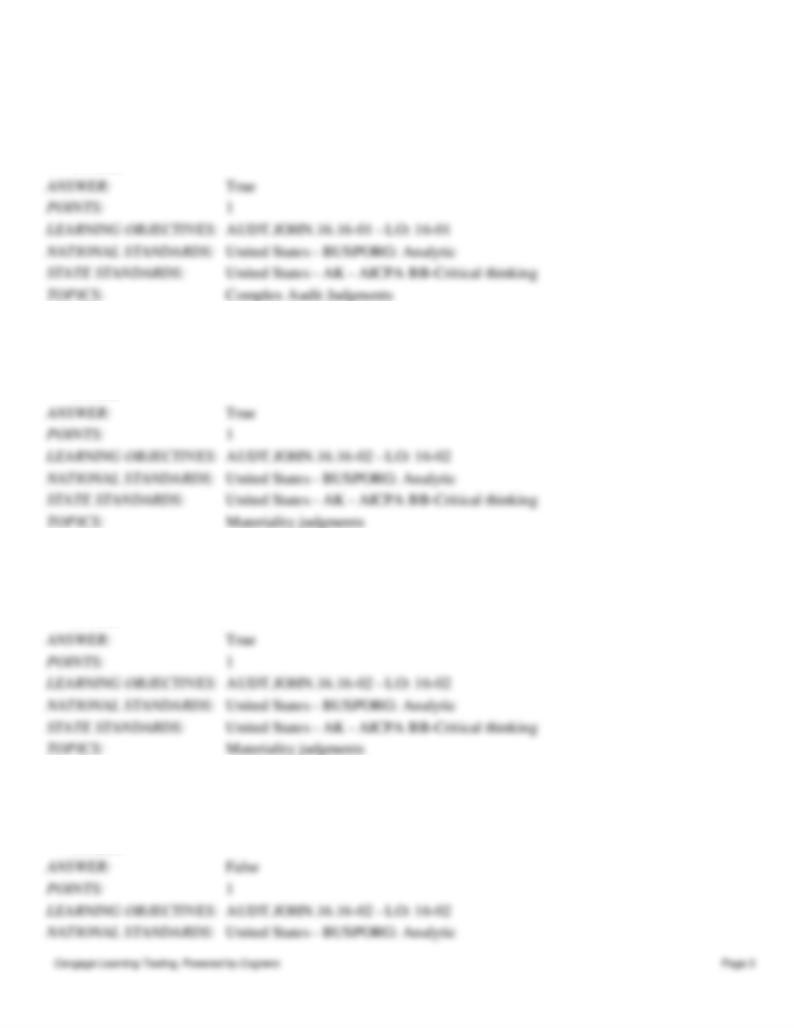
Chapter 16 - Advanced Topics Concerning Complex Auditing Judgments
9. The significant judgments related to "deferred income taxes" are subject to estimates of future profitable
operations against which the deferred asset might be utilized.
a.
True
b.
False
10. Existing professional guidance notes that auditors must make materiality assessments for purposes of (1)
audit planning and (2) evidence evaluation after audit procedures are completed.
a.
True
b.
False
11. An auditor’s consideration of materiality is a matter of professional judgment and is influenced by the
auditor’s perception of the needs of users of financial statements.
a.
True
b.
False
12. Materiality judgments are made in light of the surrounding circumstances, but need not necessarily involve
both quantitative and qualitative considerations.
a.
True
b.
False
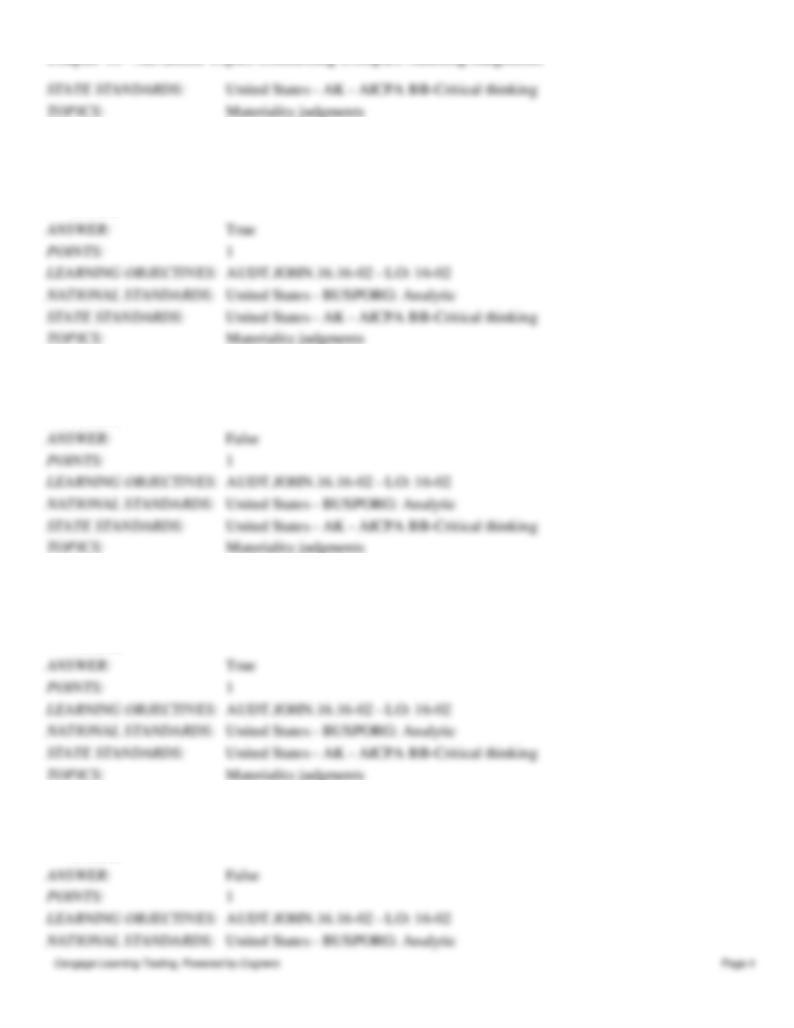
Chapter 16 - Advanced Topics Concerning Complex Auditing Judgments
13. The purpose of making materiality judgments is to make sure that financial statements are free of any
material misstatement.
a.
True
b.
False
14. The auditor considers materiality only at the overall financial statement level.
a.
True
b.
False
15. Auditors make materiality assessments to help in planning the audit evidence to obtain and in evaluating the
audit evidence that was obtained.
a.
True
b.
False
16. Determining materiality is based solely on quantitative factors.
a.
True
b.
False
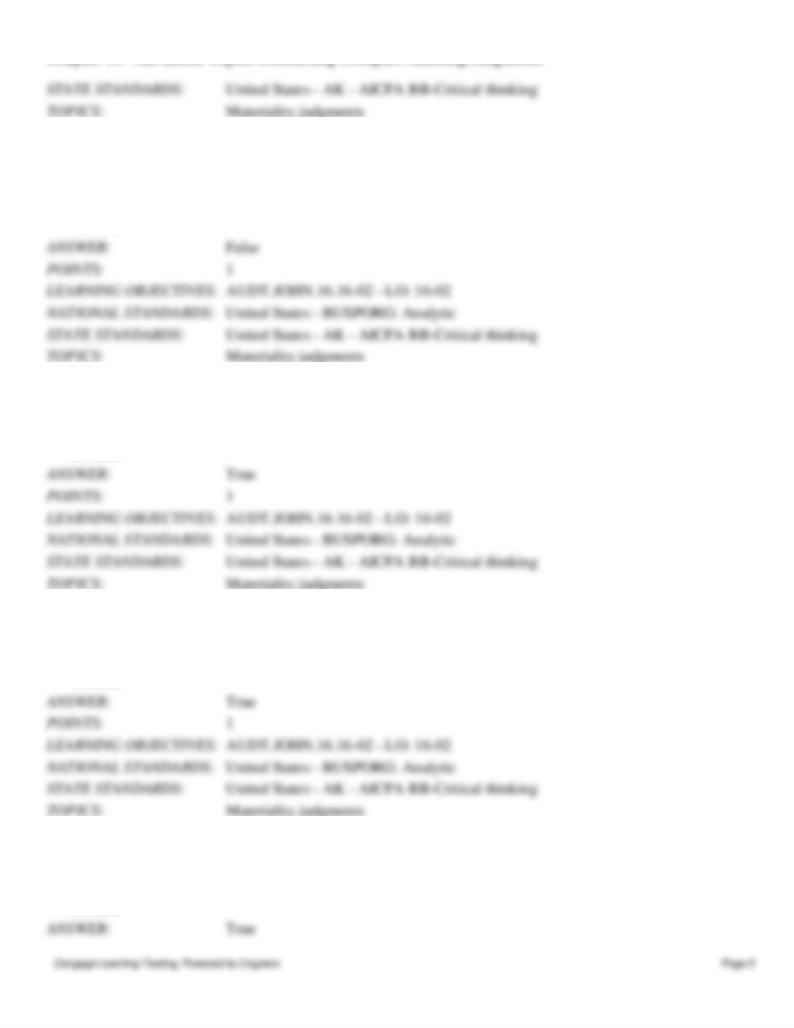
Chapter 16 - Advanced Topics Concerning Complex Auditing Judgments
17. If the auditor believes that misstatements aggregating approximately $50,000 would be material to the
income statement, but misstatements aggregating approximately $100,000 would be material to the balance
sheet, the auditor typically assesses overall materiality at $100,000 or less.
a.
True
b.
False
18. Planning materiality helps the auditor determine the extent of audit evidence needed in order to provide an
opinion on the financial statements.
a.
True
b.
False
19. In performing substantive analytical procedures, the threshold for determining whether differences between
the client’s recorded balance and the auditor’s expectation should be based on planning materiality.
a.
True
b.
False
20. If a company’s net income varies significantly from year to year, the auditor might consider using an
average of the net income from the prior three to five years as the materiality benchmark.
a.
True
b.
False
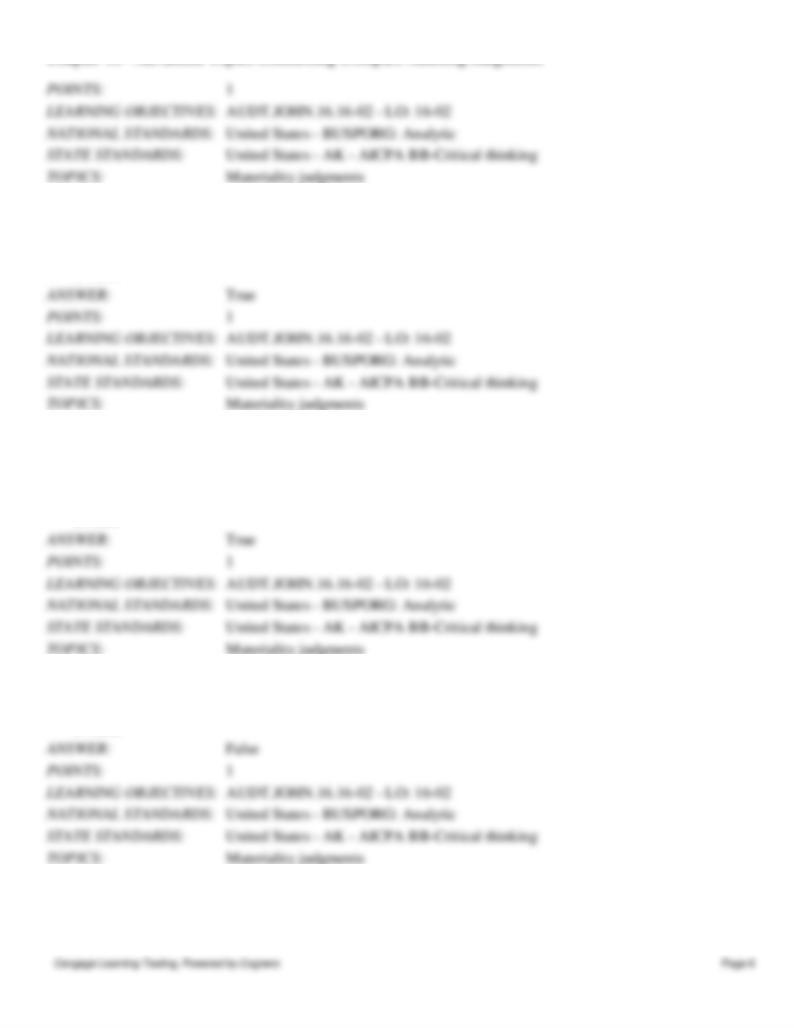
Chapter 16 - Advanced Topics Concerning Complex Auditing Judgments
21. The accumulation of which potential misstatements to accumulate for the purpose of assessing the
materiality of misstatements is often based on whether items are considered clearly trivial.
a.
True
b.
False
22. A materiality level where the auditor believes that the errors below that level would not, even when
aggregated with all other misstatements, be material to the financial statements is often based on whether
something is considered clearly trivial.
a.
True
b.
False
23. Auditors may consider only quantitative effects and not qualitative effects in making materiality judgments.
a.
True
b.
False
24. Misstatements detected during the audit that were initially deemed to be immaterial need not be summarized
to determine their aggregate effects.
a.
True
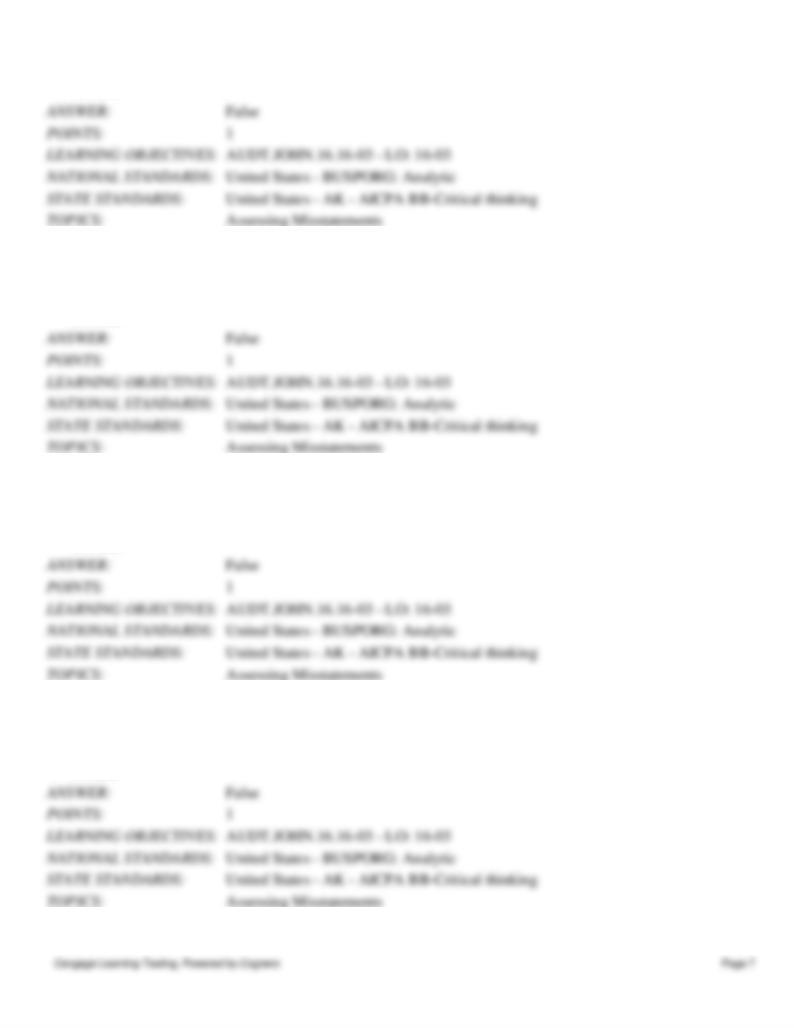
Chapter 16 - Advanced Topics Concerning Complex Auditing Judgments
b.
False
25. The auditor need not inform the audit committee about adjustments arising from the audit that were
considered to be material.
a.
True
b.
False
26. The assessment as to whether a misstatement in a cash-flow classification is material should be primarily
based on an income statement perspective.
a.
True
b.
False
27. Auditors request the client to book all known misstatements, even if the recording cost is very high so that
there are no carryovers from year to year.
a.
True
b.
False
28. The SEC’s position is generally that if management refuses to correct a material misstatement, then the
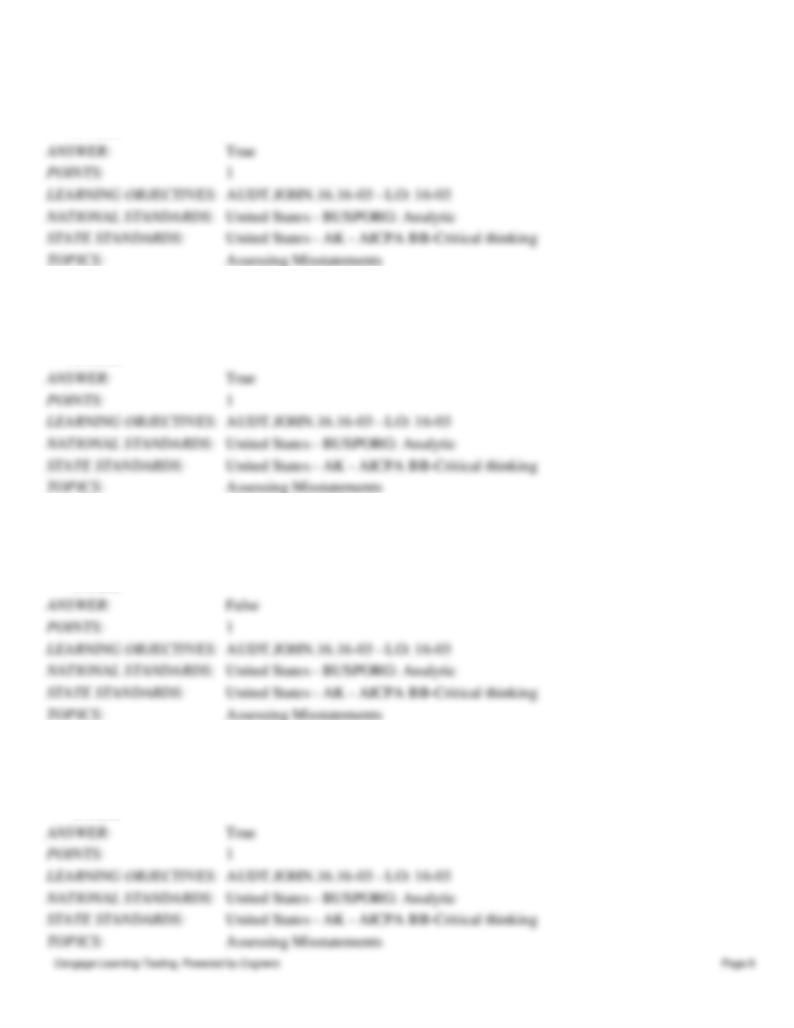
Chapter 16 - Advanced Topics Concerning Complex Auditing Judgments
auditor is obligated to issue a qualified or an adverse opinion on the financial statements.
a.
True
b.
False
29. The discovery of an intentional misstatement, even if immaterial, could impact the auditor’s opinion on the
effectiveness of the client’s internal control over financial reporting.
a.
True
b.
False
30. The iron curtain method for assessing materiality focuses on assuring that the year-end balance sheet is
correct and considers the impact of prior-year uncorrected misstatements reversing in later years.
a.
True
b.
False
31. The SEC issued SAB 108 in 2006, which mandates what is termed a dual approach to assessing uncorrected
misstatements.
a.
True
b.
False
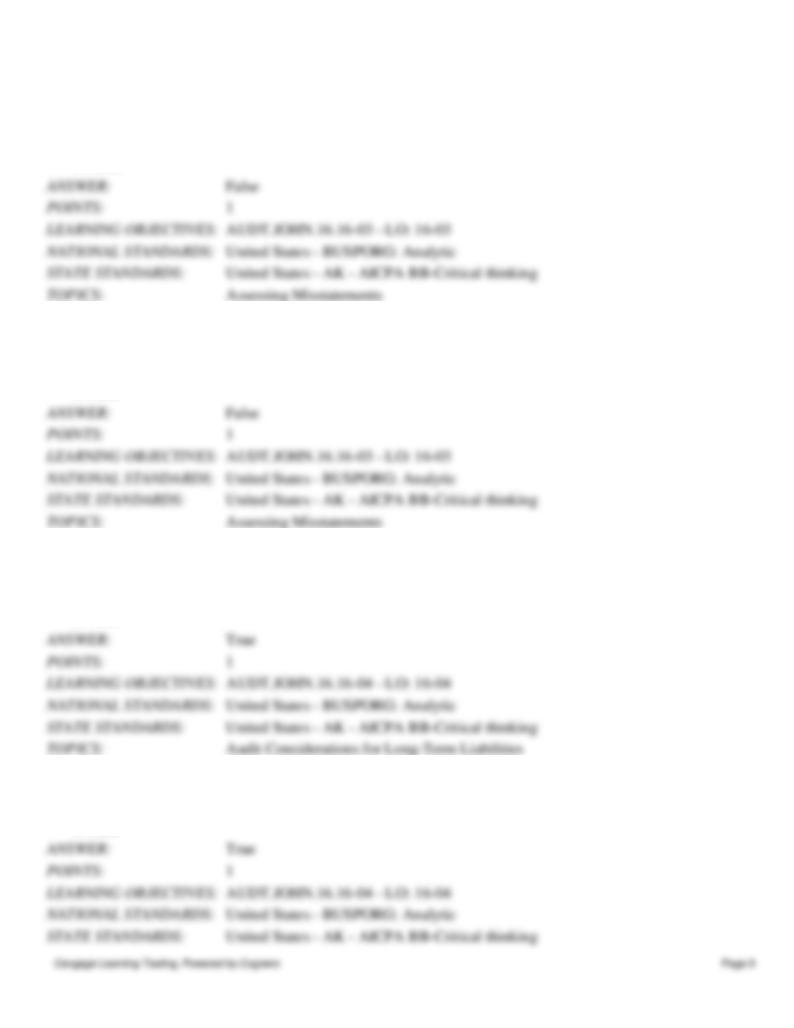
Chapter 16 - Advanced Topics Concerning Complex Auditing Judgments
32. A misstatement that is intentional is not assessed any differently by the auditor than a misstatement that is
unintentional.
a.
True
b.
False
33. When evaluating identified misstatements, the auditor only needs to consider misstatements in the current
year, and not misstatements from the prior year.
a.
True
b.
False
34. Auditors can choose to test the client’s warranty reserves using primarily tests of controls and substantive
analytical procedures.
a.
True
b.
False
35. When auditing pension obligations, the auditor will likely use a specialist to assist the audit team.
a.
True
b.
False
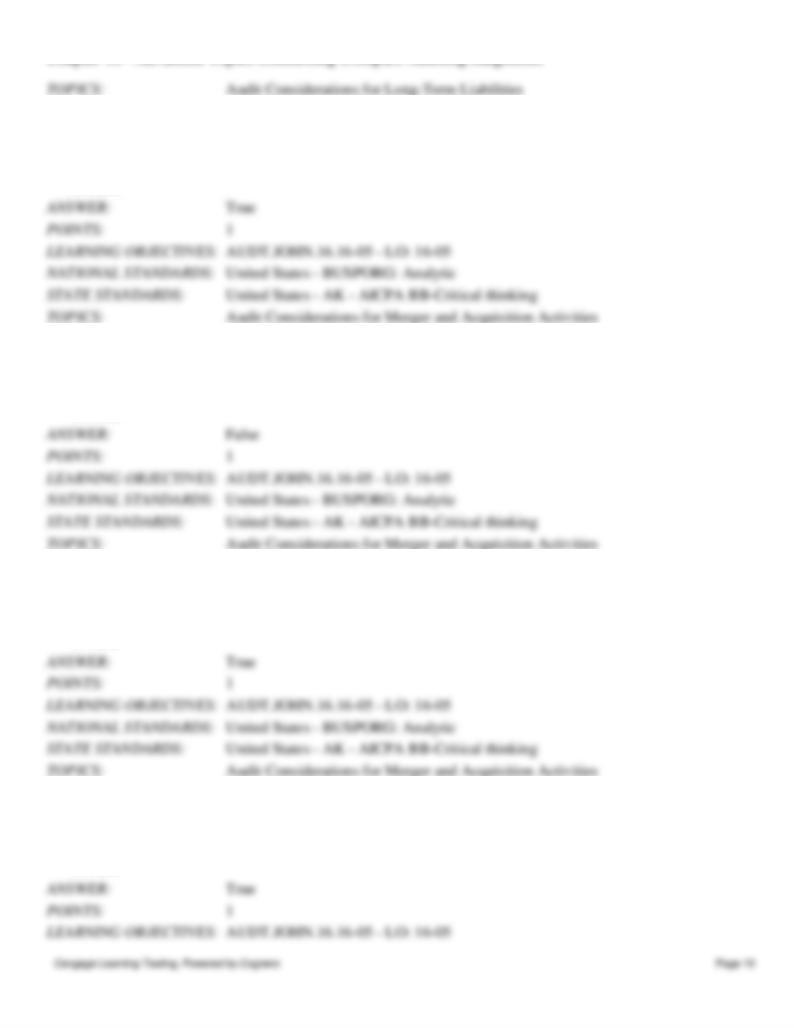
Chapter 16 - Advanced Topics Concerning Complex Auditing Judgments
36. Goodwill is the excess of the purchase price over the fair market value of the acquired company’s tangible
assets, identifiable intangible assets, and liabilities.
a.
True
b.
False
37. Because of conservatism considerations, auditors should allow a client to overestimate its reserve for
restructuring.
a.
True
b.
False
38. Goodwill has to be evaluated for impairment once a year, as well as on an interim basis as the time events
and circumstances warrant.
a.
True
b.
False
39. If the market value of the reporting unit is below book value and a significant amount of goodwill exists, the
presumption is that there has been an impairment of goodwill.
a.
True
b.
False
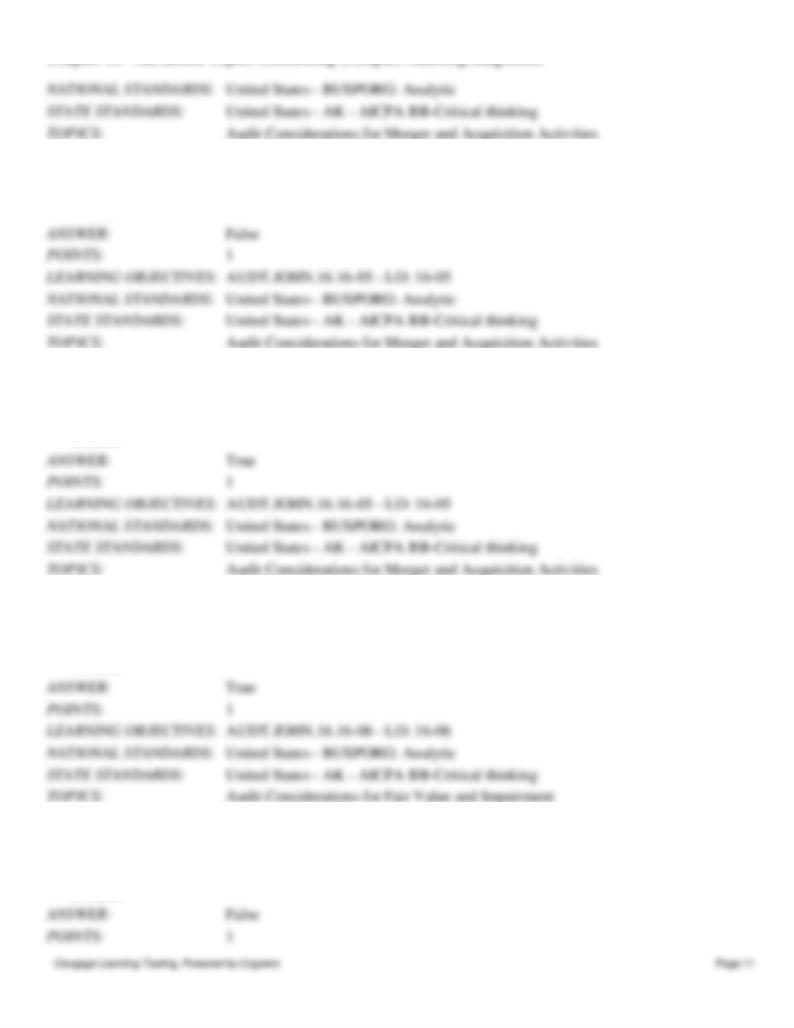
Chapter 16 - Advanced Topics Concerning Complex Auditing Judgments
40. Goodwill arising from many acquisitions can be netted into one test at the company level.
a.
True
b.
False
41. If restructuring charges are not calculated correctly, the charges can be used to fraudulently manipulate
income.
a.
True
b.
False
42. In assessing the fair value of Level 1 assets, the auditor can perform an analysis of the volume of trading
activity as part of obtaining audit evidence.
a.
True
b.
False
43. When assessing fair value of Level 2 assets, auditors will use information on the sale of identical items in
active or inactive markets as a source of audit evidence.
a.
True
b.
False
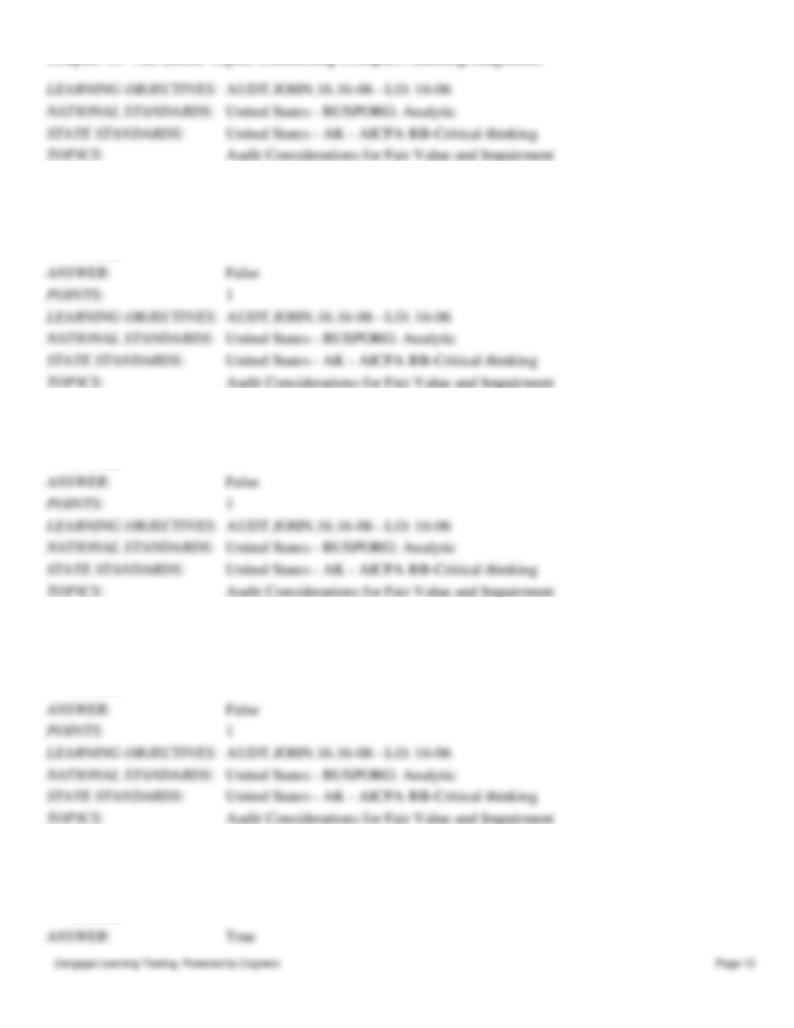
Chapter 16 - Advanced Topics Concerning Complex Auditing Judgments
44. Level 1 assets is a broad category of assets and applies to financial instruments, property, or lower of cost or
market considerations for inventory, loans, or receivables.
a.
True
b.
False
45. Audits of Level 3 assets are the most straightforward as they involve an observable, active market.
a.
True
b.
False
46. Assuming that other assets have been properly valued, if the market value of the reporting unit is equal to
the carrying value of the assets of the reporting unit, the presumption is that goodwill has been impaired.
a.
True
b.
False
47. Current FMV of assets and liabilities of non-goodwill assets is one of the factors affecting goodwill
impairment valuations.
a.
True
b.
False
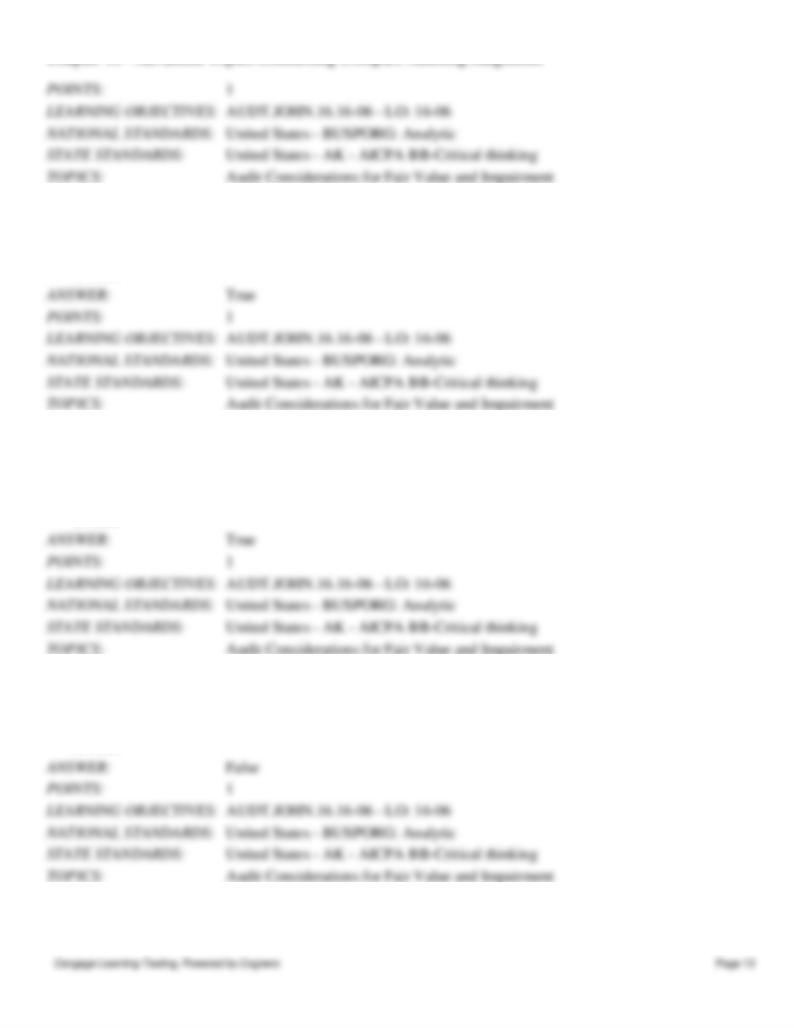
Chapter 16 - Advanced Topics Concerning Complex Auditing Judgments
48. A sensitivity analysis of changes in value based on industry and cash-flow assumptions is one of the aspects
of the audit program for goodwill impairment testing.
a.
True
b.
False
49. While performing goodwill impairment testing, if the original reporting unit no longer exists because
operations have been fully integrated into operations of the parent company, the approach would be to
determine whether all other assets have been adjusted to fair value, where applicable.
a.
True
b.
False
50. U.S. accounting standards require organizations to use a two-step process to determine the impairment of
goodwill.
a.
True
b.
False
51. An audit of Level 1 assets is likely to be less challenging than an audit of Level 3 assets.
a.
True
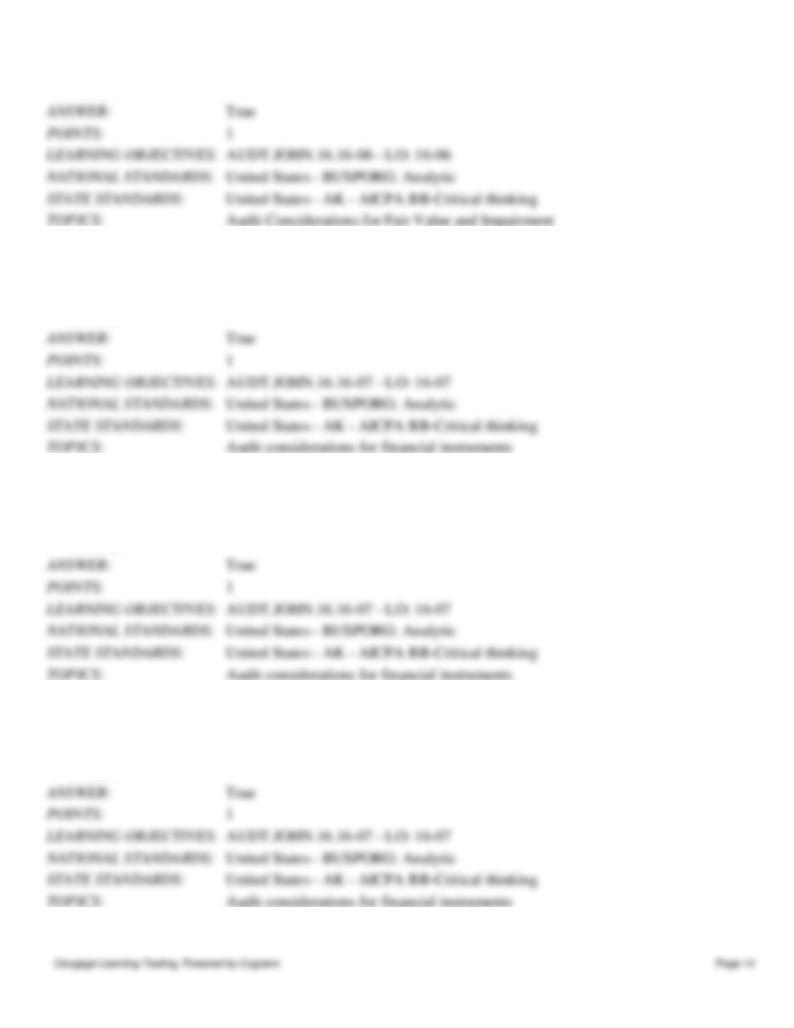
Chapter 16 - Advanced Topics Concerning Complex Auditing Judgments
b.
False
52. When there is a ready market for financial instruments, the audit procedures related to valuation and
disclosures are more straightforward than when the instrument is not readily marketable.
a.
True
b.
False
53. When auditing financial hedges, the auditor should understand the product, identify relevant risks and
controls, and understand the appropriate accounting.
a.
True
b.
False
54. The significant judgments related to debt depend on specific accounting rules (U.S. or international) that the
company is following.
a.
True
b.
False
55. The volume of transactions affected is one of the critical criteria in assessing identified internal control

Chapter 16 - Advanced Topics Concerning Complex Auditing Judgments
deficiencies.
a.
True
b.
False
56. Evidence of fraud, whether or not material, on the part of senior management, would likely cause the auditor
to conclude that the client had a material weakness in internal control over financial reporting.
a.
True
b.
False
57. A compensating control would not be considered as a factor that could mitigate a potential material
weakness.
a.
True
b.
False
58. In the U.S. a CPA firm can provide both internal and external audit services for the same public company
client.
a.
True
b.
False
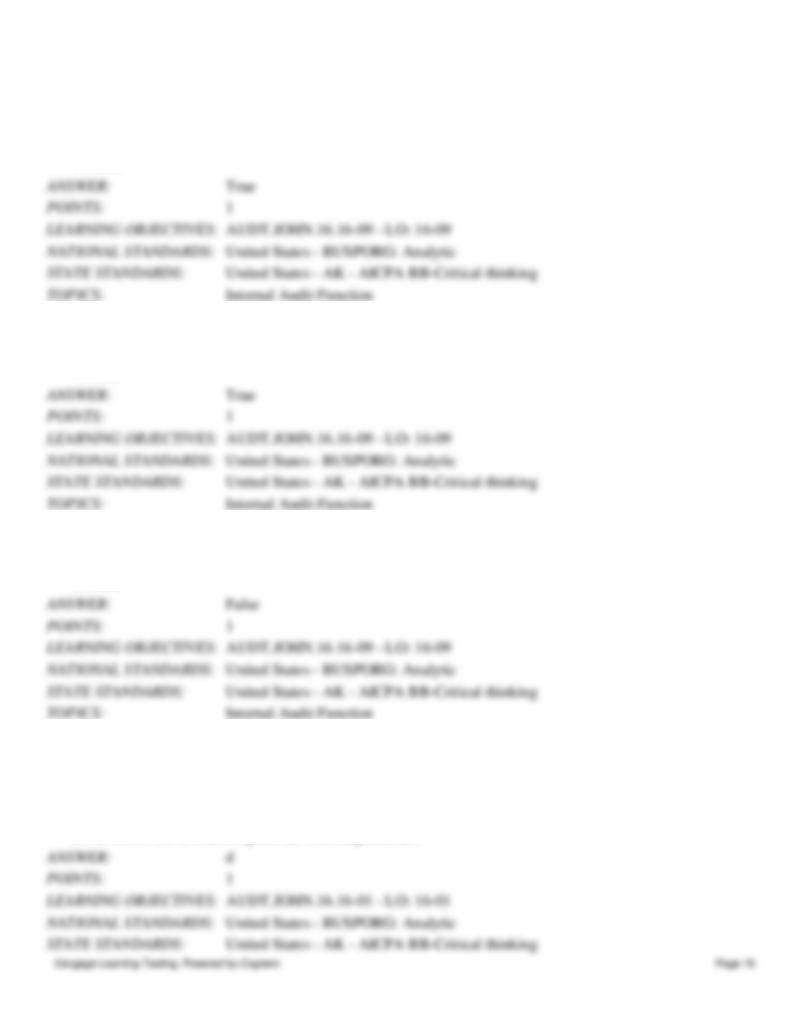
Chapter 16 - Advanced Topics Concerning Complex Auditing Judgments
59. Independence of the internal audit function is obtained by giving the Chief Audit Executive (CAE)
unrestricted access to the board and senior management.
a.
True
b.
False
60. Internal auditors can perform both consulting services and assurance services.
a.
True
b.
False
61. All internal auditors are required to have the CIA designation in order to practice internal auditing.
a.
True
b.
False
62. Which of the following is subject to fair value assessment?
a.
Marketable securities.
b.
Inventory.
c.
Property that will be sold.
d.
All of the above could require fair value adjustments.
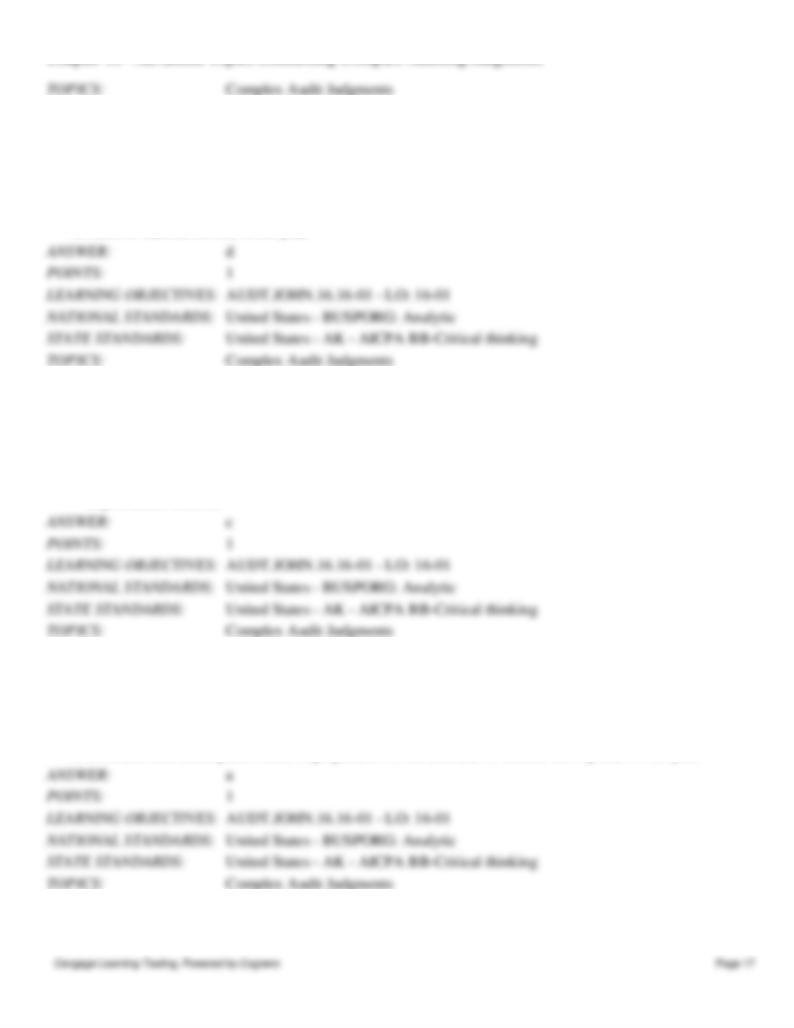
Chapter 16 - Advanced Topics Concerning Complex Auditing Judgments
63. Which of the following is least likely to require significant auditor judgment about the dollar amount to be
disclosed in the financial statement?
a.
Contingent liability related to pending litigation.
b.
Assumptions made in preparation of the estimate of income tax expense for the year.
c.
The value of inventory.
d.
Cash on hand at the end of the year.
64. Which of the following statements best describe an issue related to inventory?
a.
Impairment testing based on most likely sale or disposal price.
b.
Subject to allowance for noncollectibility.
c.
Lower of cost or market impairments, including an allowance for obsolescence.
d.
Subject to estimates made regarding the expected life of the assets and the appropriateness of the
depreciation method.
65. Which of the following best describes the nature of assets of held-for-sale operations?
a.
Impairment testing based on most likely sale or disposal price.
b.
Impairment testing if plants are closed or equipment is not used.
c.
Lower of cost or market impairments, including an allowance for obsolescence.
d.
Estimates and assumptions made in preparation of the estimate of income tax expense for the year.
66. Almost every asset and liability account requires significant judgments. Which of the following judgments
is subject to allowance for noncollectibility?
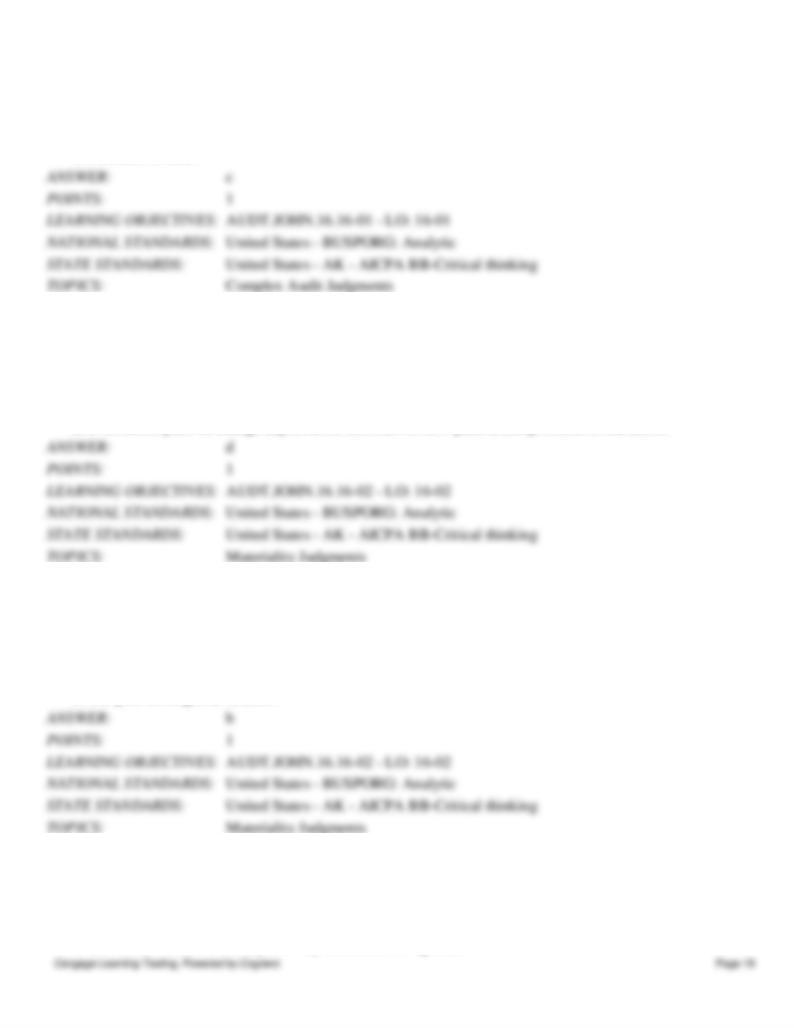
Chapter 16 - Advanced Topics Concerning Complex Auditing Judgments
a.
Inventories.
b.
Marketable securities.
c.
Other receivables.
d.
Deferred revenue.
67. In which of the following cases is it not necessary for an auditor to revise the original materiality level and
document the new materiality amount, as well as the rationale for changing the amount?
a.
If there is a change in circumstances that involve laws, regulations, or the accounting framework.
b.
If there is new information resulting from the risk assessment of the client.
c.
If there are changes in the understanding of the client about a new contractual agreement.
d.
If the client plans to change depreciation methods for new plant assets procured in the future.
68. What document is prepared so that auditors can aggregate potential misstatements in order to assess the
materiality of misstatements?
a.
The audit opinion.
b.
The summary of unadjusted audit differences.
c.
The summary of earnings trends.
d.
The post-closing trial balance.
69. Which of the following statements is not true regarding the use of a judgmental approach by auditors in
determining whether a misstatement is clearly trivial?
a.
The determination is based on past auditor experience.
b.
The determination is usually not very defensible to third-party users.
c.
The determination is usually not very defensible to regulators.
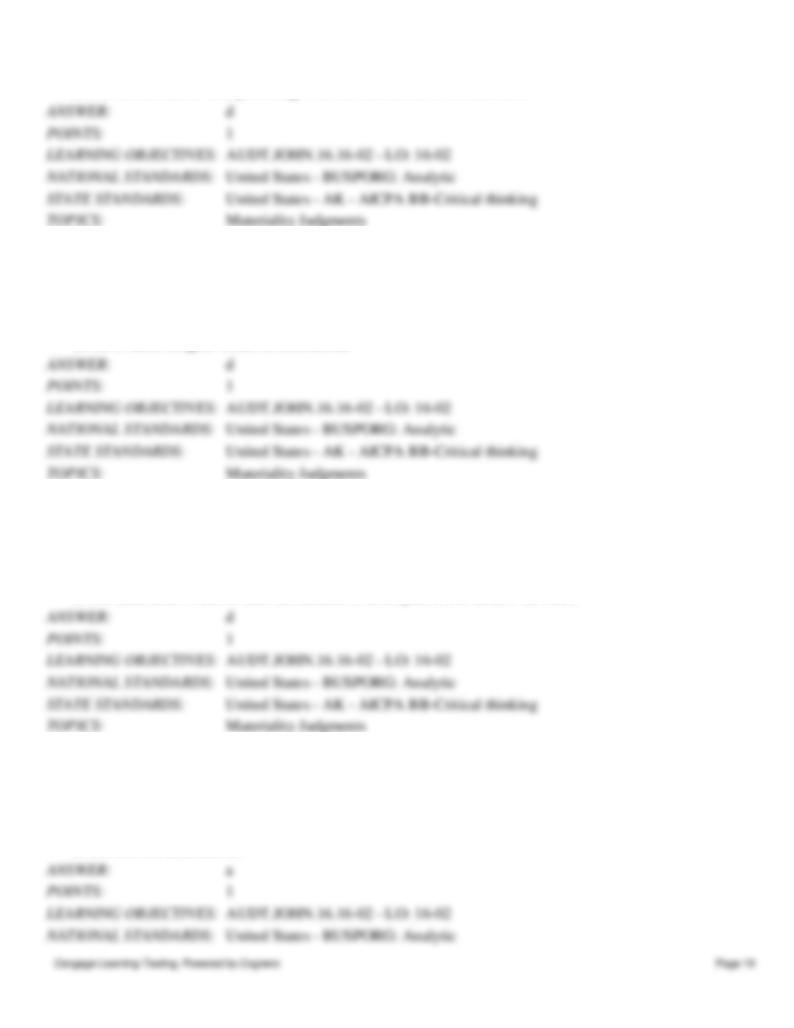
Chapter 16 - Advanced Topics Concerning Complex Auditing Judgments
d.
The determination uses percentages for the likelihood of misstatement.
70. Which of the following will the auditor will not consider when making a materiality determination?
a.
Potential default on loan covenants.
b.
Changes in segment earnings or trends in earnings.
c.
Factors that would affect the market’s perception of future growth and cash flow for the company.
d.
All of these insights would be considered.
71. Which of the following would not be a reason to lower the threshold for materiality?
a.
The auditor is concerned with potential violations of debt covenants.
b.
There were proposed adjusting entries to a particular account in prior years.
c.
The consequences of a potential misstatement in an account balance are very high.
d.
The audit team wants to limit the amount of time spent at the client’s facilities.
72. Performance materiality helps the auditor to determine which of the following?
a.
Extent of audit evidence needed.
b.
The specific analytical procedures to perform.
c.
The specific substantive procedures to perform.
d.
Control risk assessment.
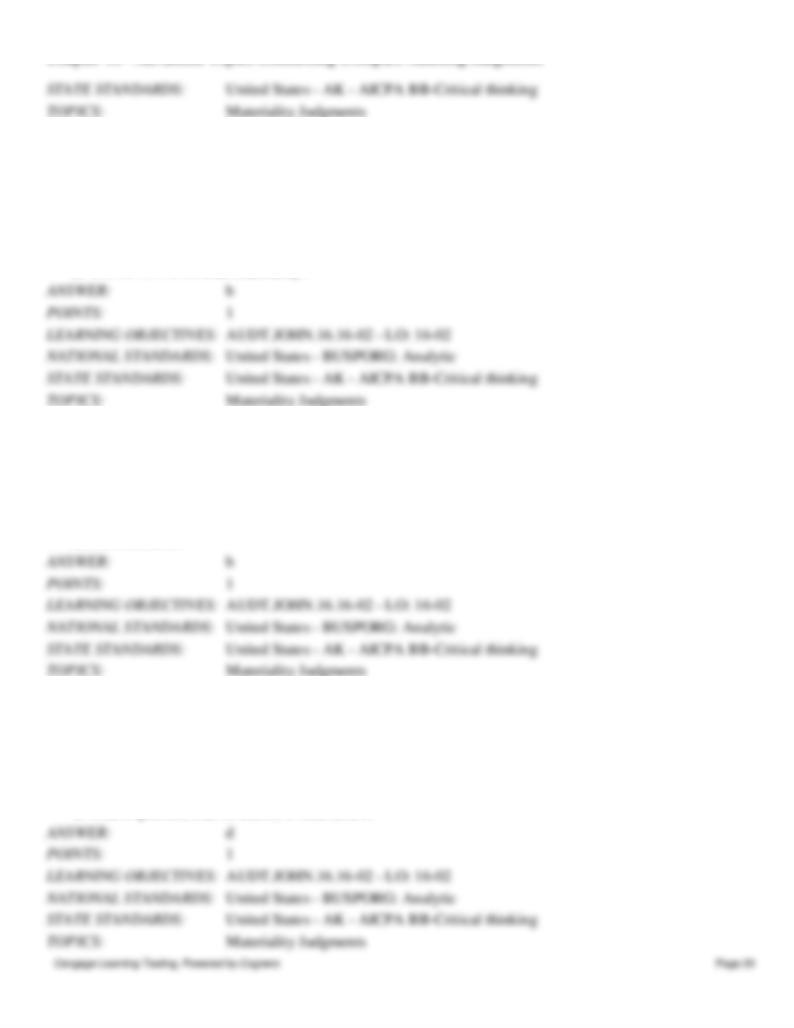
Chapter 16 - Advanced Topics Concerning Complex Auditing Judgments
73. Although different audit firms take different approaches, performance materiality could be the same as
overall materiality, or could be a percentage of overall materiality. Generally this range is which of the
following?
a.
25% to 75% of overall materiality.
b.
50% to 75% of overall materiality.
c.
25% to 50% of overall materiality.
d.
40% to 75% of overall materiality.
74. When a client has significant and nonrecurring charges to nonoperating expenses, which of the following
would be the most appropriate materiality benchmark?
a.
Net profit.
b.
Income from continuing operations.
c.
Cash inflows.
d.
Cash outflows.
75. For nonprofit entities, appropriate benchmarks for materiality judgments would include which of the
following?
a.
Total assets and total liabilities.
b.
Total revenues and total assets.
c.
Total liabilities, total income, or total assets.
d.
Total expenses, total revenues, or total assets.
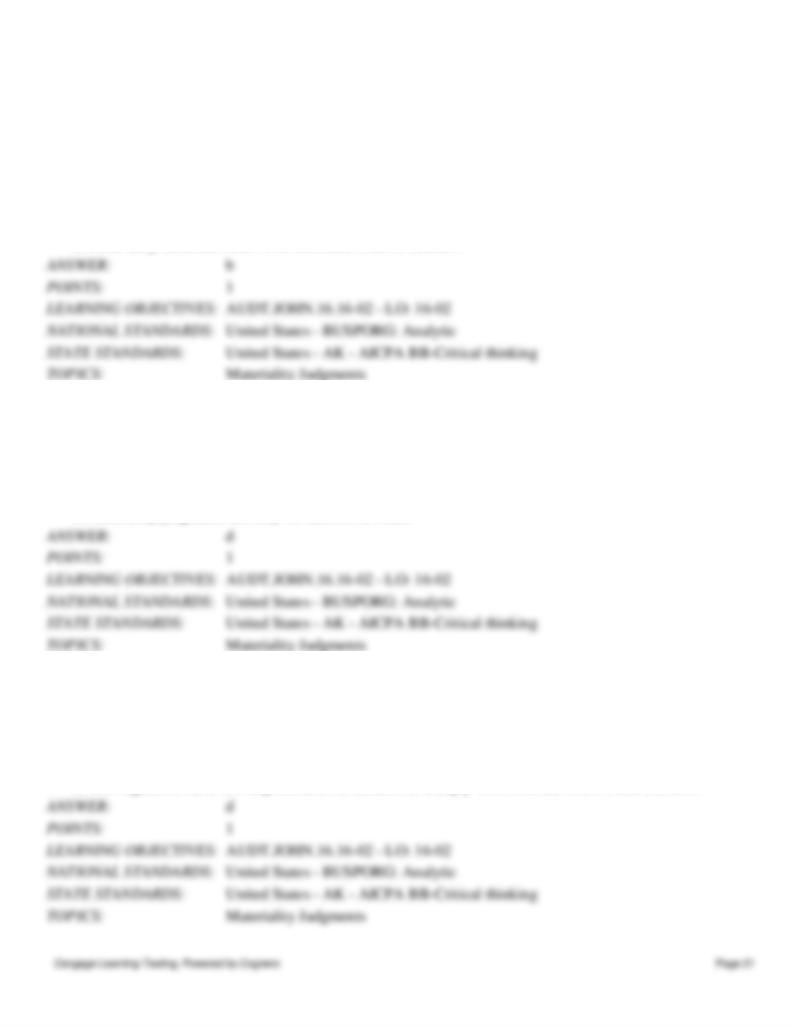
Chapter 16 - Advanced Topics Concerning Complex Auditing Judgments
76. Which of the following statements is not true about materiality judgments?
a.
The auditor’s consideration of materiality is influenced by the auditor’s perception of the needs of
users of financial statements.
b.
The auditor considers materiality only in relation to classes of transactions, account balances, and
disclosures.
c.
Materiality judgments are used to help the auditor gather sufficient appropriate evidence about
whether the financial statements are free of material misstatement.
d.
Materiality decisions differ from one audit client to another.
77. Which of the following statements is false regarding materiality judgments?
a.
Materiality judgments are a matter of professional judgment.
b.
Materiality judgments depend on the needs of a reasonable person (an investor, potential investor, or
other stakeholder) relying on the information.
c.
Materiality judgments involve both quantitative and qualitative considerations.
d.
Materiality judgments are easy for auditors to make.
78. Which of the following is not a factor adding to the complexity of materiality judgments made by auditors?
a.
Regulators pay particular attention to the judgmental aspects of auditor materiality decisions.
b.
SEC regulators do not believe it is appropriate to use percentage terms to substitute for a full analysis
of all relevant considerations regarding the magnitude of misstatement.
c.
Regulators focus on how materiality decisions can affect client financial results.
d.
SEC regulators have few requirements for auditors to comply with since the AICPA fills that role.
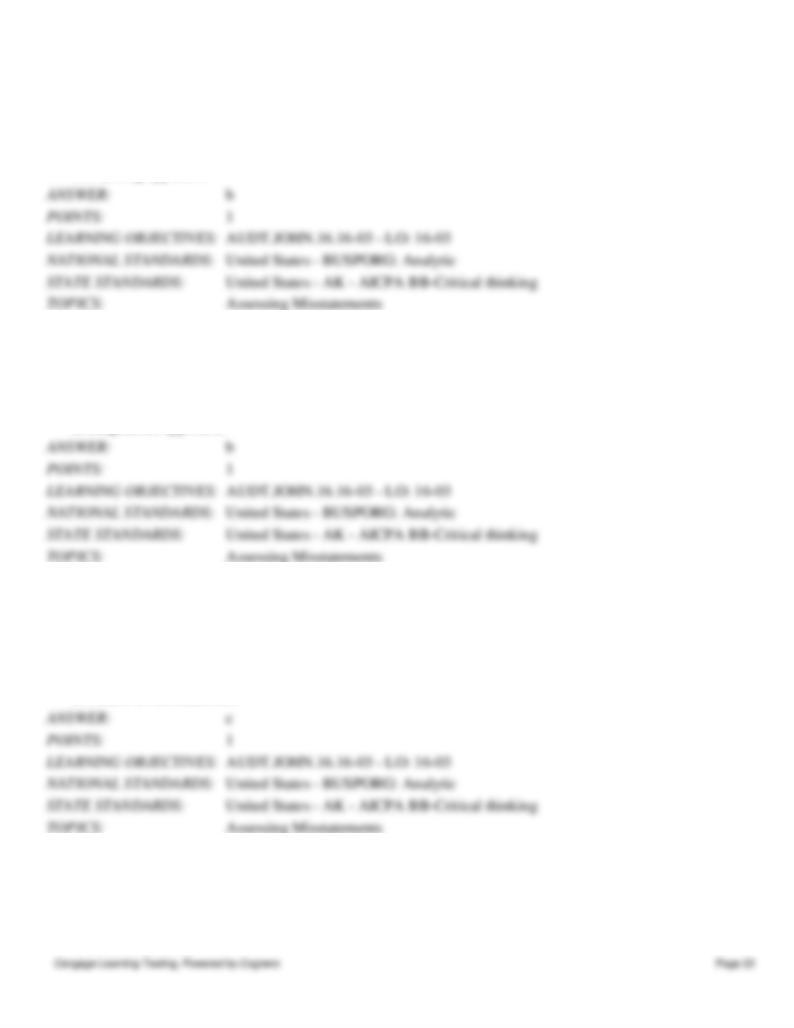
Chapter 16 - Advanced Topics Concerning Complex Auditing Judgments
79. Which of the following is an approach used to determine posting material?
a.
Dual approach.
b.
Percentage approach.
c.
Qualitative approach.
d.
Planning approach.
80. According to SAB 108, what approach is used when assessing uncorrected misstatements?
a.
Matrix approach.
b.
Dual approach.
c.
Percentage approach.
d.
Judgmental approach.
81. Misstatements detected during the audit that were initially deemed to be immaterial must be summarized to
determine which of the following?
a.
Materiality.
b.
Quantitative effect.
c.
Aggregate effects.
d.
Nature of misstatement.
82. The adjustments arising from the audit that were considered to be material should be communicated by the
auditor to which of the following?
a.
Audit staff.
b.
Management.
c.
Audit committee.
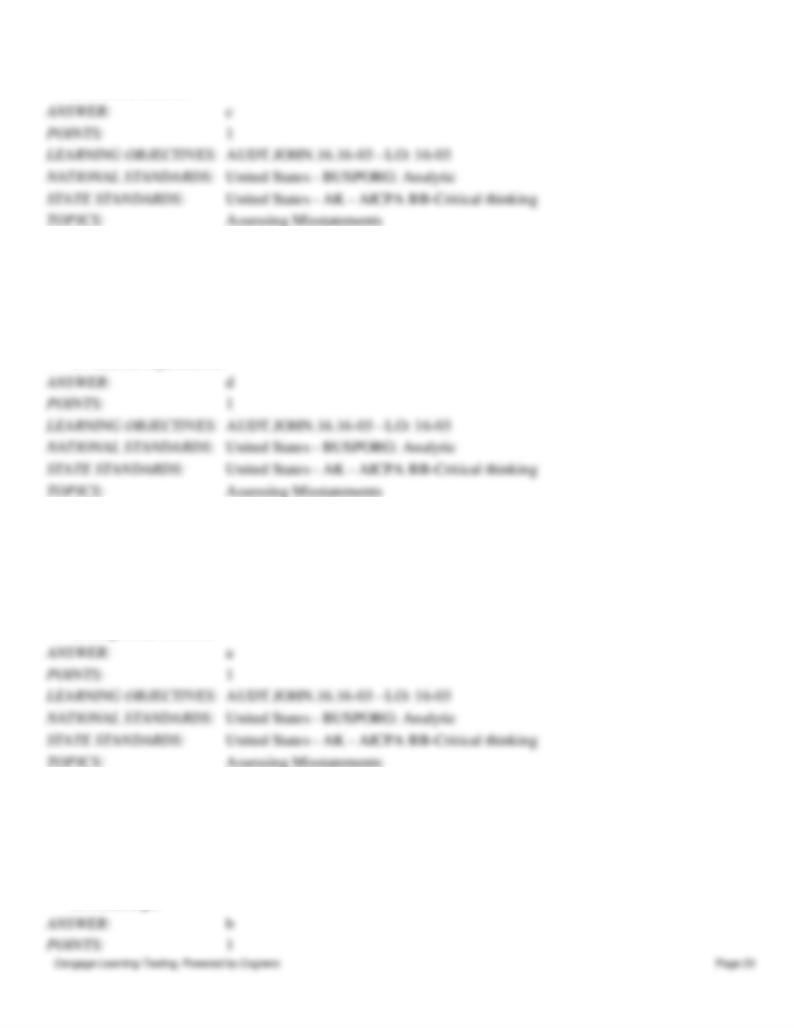
Chapter 16 - Advanced Topics Concerning Complex Auditing Judgments
d.
Internal auditors.
83. The auditor should have a sound basis, supported by objective evidence, regarding accounting estimates and
should not fall victim to an “all estimates are subjective” argument in order to waive which of the following?
a.
Contingent liability.
b.
Material misstatements.
c.
Unrecorded liability.
d.
Material adjustments.
84. Which method focuses on the materiality of current year misstatements and the reversing effect of prior-
year misstatements on the income statement?
a.
Rollover method.
b.
Iron curtain method.
c.
Percentage approach.
d.
Judgmental method.
85. Which method focuses on assuring that the year-end balance sheet is correct and does not consider the
impact of prior-year uncorrected misstatements reversing in later years?
a.
Rollover.
b.
Iron curtain.
c.
Dual.
d.
Percentage.
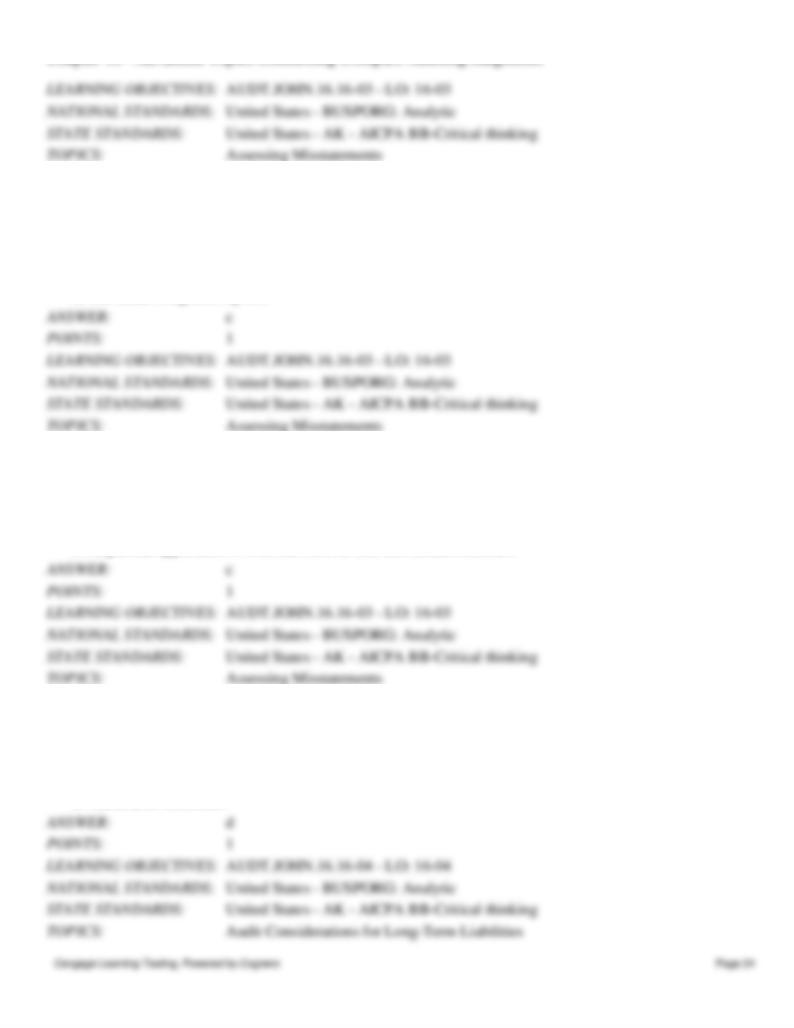
Chapter 16 - Advanced Topics Concerning Complex Auditing Judgments
86. The discovery of an intentional misstatement, even if immaterial, could impact the auditor’s opinion on the
effectiveness of which of the following?
a.
The client’s external controls.
b.
The client’s interim financial statements.
c.
The client’s internal controls over financial reporting.
d.
The client’s segment reports.
87. Which of the following is required by the dual approach for assessing uncorrected misstatements?
a.
The application of the rollover method.
b.
The application of the iron curtain method.
c.
Simultaneous application of both the rollover and iron curtain methods.
d.
Sequential application of both the rollover and iron curtain methods.
88. Which of the following is not a long-term liability account with a high risk of material misstatement?
a.
Warranty reserves.
b.
Pension obligations.
c.
Other postemployment benefits.
d.
Marketable securities.
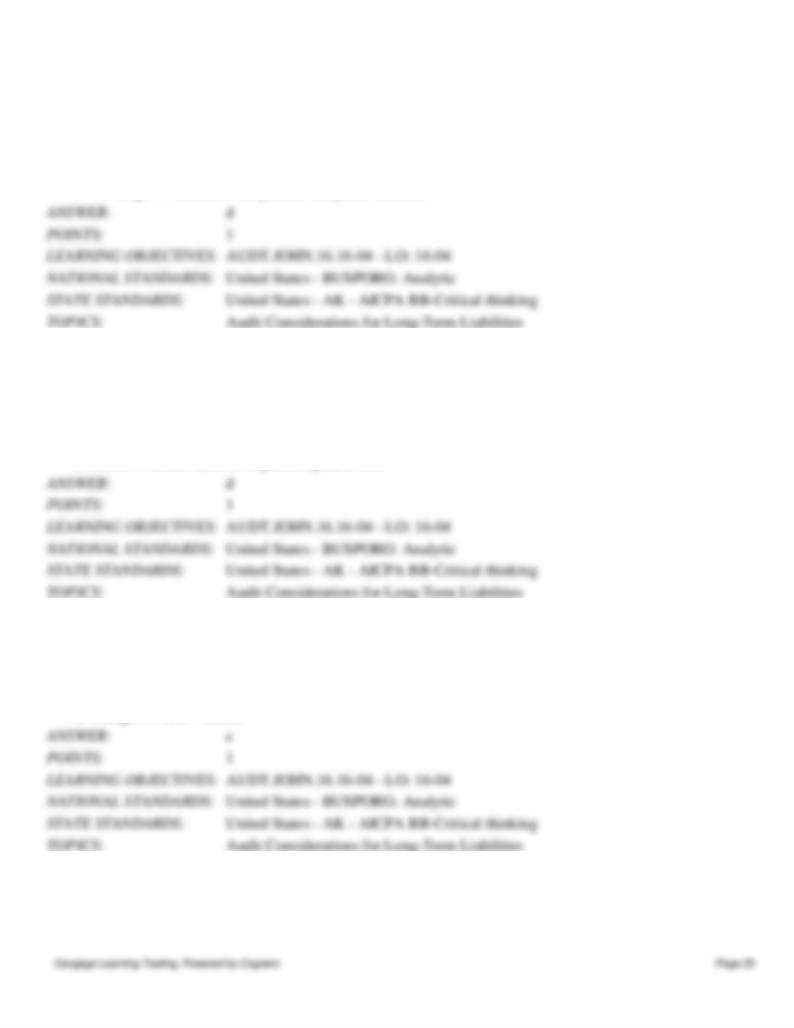
Chapter 16 - Advanced Topics Concerning Complex Auditing Judgments
89. Which of the following is not a key type of evidence that the auditor needs to examine with respect to
pensions and postemployment benefits?
a.
Whether the actuarial firm hired by management is independent, capable, and objective.
b.
The appropriateness of the actuarial firm’s work.
c.
The reasonableness of significant interest rate assumptions.
d.
The length of illnesses that pension recipients contract.
90. Which of the following is not an element of pensions and other postemployment benefits that is difficult to
estimate?
a.
Projected lifetime of former employees that will receive a pension.
b.
The future earnings of employees prior to retiring for defined benefit plans.
c.
Long-term interest rates to discount future costs back to present value.
d.
Current amounts earned on pension plan assets.
91. Which of the following factors would be least likely to affect the estimate of the warranty liability?
a.
Changes in the product.
b.
Changes in the nature of the warranty.
c.
Changes in the sales staff.
d.
Changes in sales volume.
92. An audit of the other postemployment benefits does not require estimates with respect to which of the
following?
a.
Changes in medical expenses.
b.
Changes in coverage.
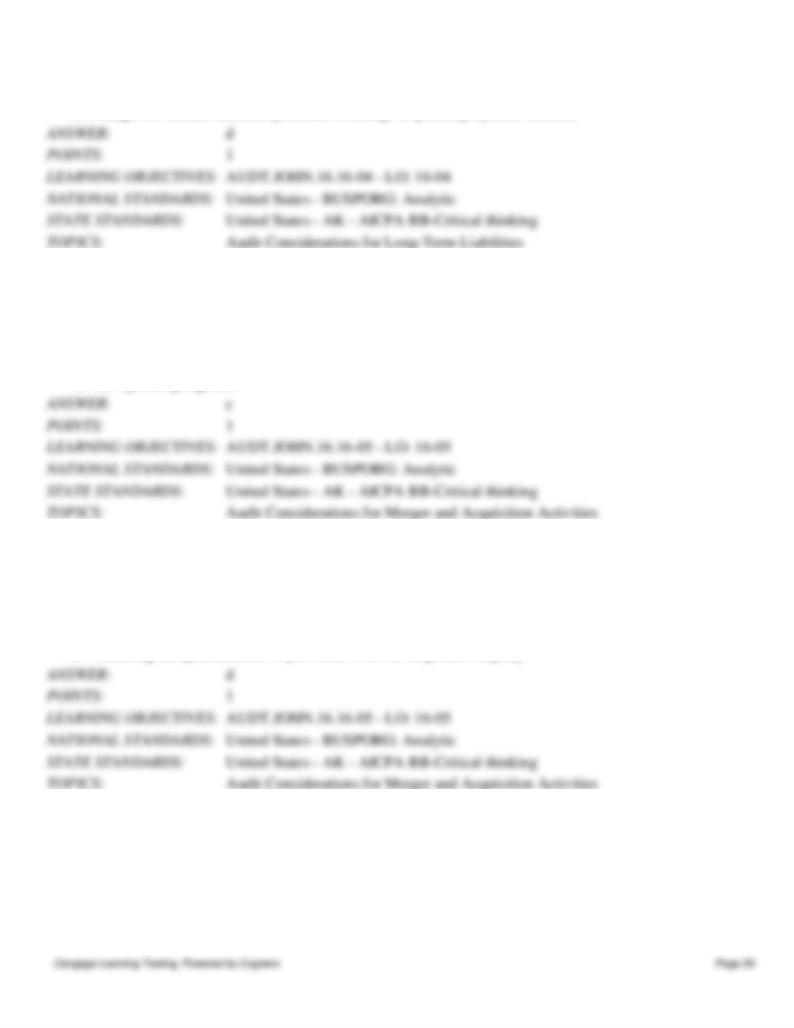
Chapter 16 - Advanced Topics Concerning Complex Auditing Judgments
c.
Changes in average life expectancies.
d.
Changes in Human Resource personnel in charge of postemployment benefits.
93. If an acquired company remains intact after it has been acquired, it is defined as which of the following
types of segments?
a.
Financing segment.
b.
Investing segment.
c.
Operating segment.
d.
Non-operating segment.
94. Which of the following is not a significant challenge related to valuation issues for audits of merger and
acquisition transactions?
a.
Valuing the assets upon acquisition.
b.
Valuing the liabilities upon acquisition.
c.
Measuring restructuring charges.
d.
Measuring the qualifications of personnel from the acquired company.
95. Which one of the following is not an audit procedure used when testing restructuring charges?
a.
Review current and proposed financial accounting standards to determine if changes have occurred
in accounting for restructuring.
b.
Evaluate the qualifications of management.
c.
Mathematically test the estimates.
d.
Review and independently test the estimates by reviewing (a) contracts, (b) appraisals for property or
estimates from investment bankers, and (c) severance contracts.
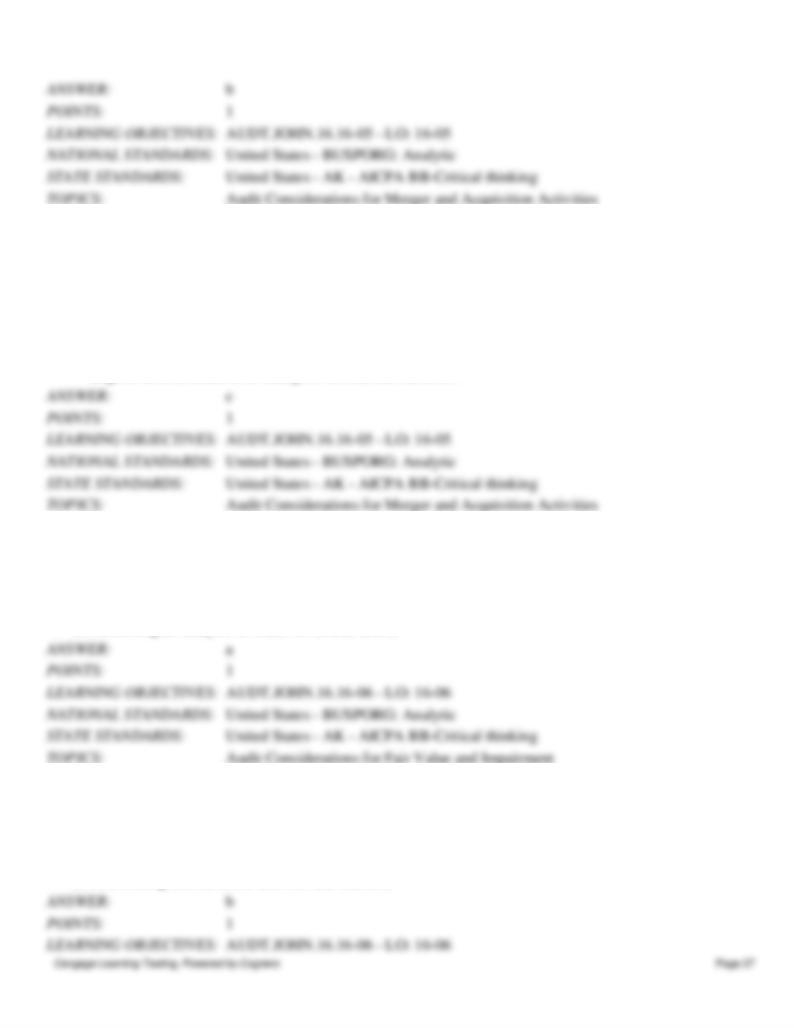
Chapter 16 - Advanced Topics Concerning Complex Auditing Judgments
96. Which of the following is false regarding the valuation of goodwill?
a.
U.S. accounting standards require that goodwill be specifically identified with an operating segment
or a reporting unit.
b.
By definition, acquired parts of the business (or goodwill) must be sufficiently identifiable so that
they can be managed as a unit or may be separately identified and sold as a unit.
c.
Goodwill is tested for impairment quarterly.
d.
Goodwill is the excess of the purchase price over the fair market value of the acquired company’s
tangible assets, identifiable intangible assets, and liabilities.
97. Which of the following approaches for determining fair value of Level 3 assets is used by the auditor?
a.
Determining appropriate model and sensitivity of model.
b.
Reviewing contracts to determine if loss is other than temporary.
c.
Performing an analysis of volume of trading activity.
d.
Performing an analysis of trades on similar assets.
98. Which of the following is not an audit challenge relevant to fair value estimation of Level 1, 2, and 3 assets?
a.
Determining identical assets and active markets.
b.
Assessing client methodology and cash flows to originally estimate value.
c.
Determining appropriate model and inputs expected cash flows.
d.
Determining similar assets and relevant markets.
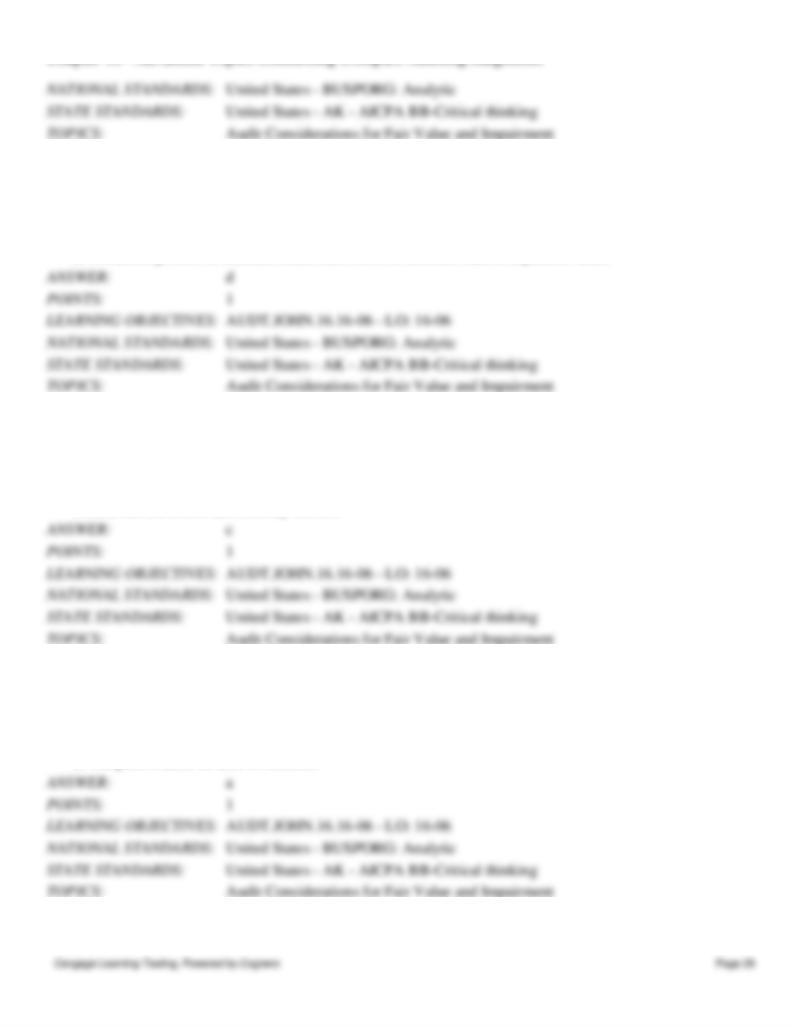
Chapter 16 - Advanced Topics Concerning Complex Auditing Judgments
99. Which of the following should the client have as part of its process for estimating fair value?
a.
A systematic process to identify each asset that is subject to realizable value estimation.
b.
A process to identify relevant historical values.
c.
An analysis of transactions that have taken place within the client’s organization.
d.
A realistic process to estimate future cash flows to discount back to a present value.
100. In the FASB hierarchy of inputs to consider for assessing fair value, which is associated with Level 1?
a.
Observable information on similar items.
b.
Nonexistence of active markets.
c.
Quoted prices on identical items.
d.
Relevant economic and industry factors.
101. In the audit approach for assessing fair value, which should the auditor determine for Level 2 assets?
a.
The correspondence of the client’s assets to similar assets in an active market.
b.
Contingent liabilities.
c.
Sensitivity of model used for marking to model.
d.
The performance of tests of controls.
102. Which one of the following statements is not accurate about goodwill impairment valuations?
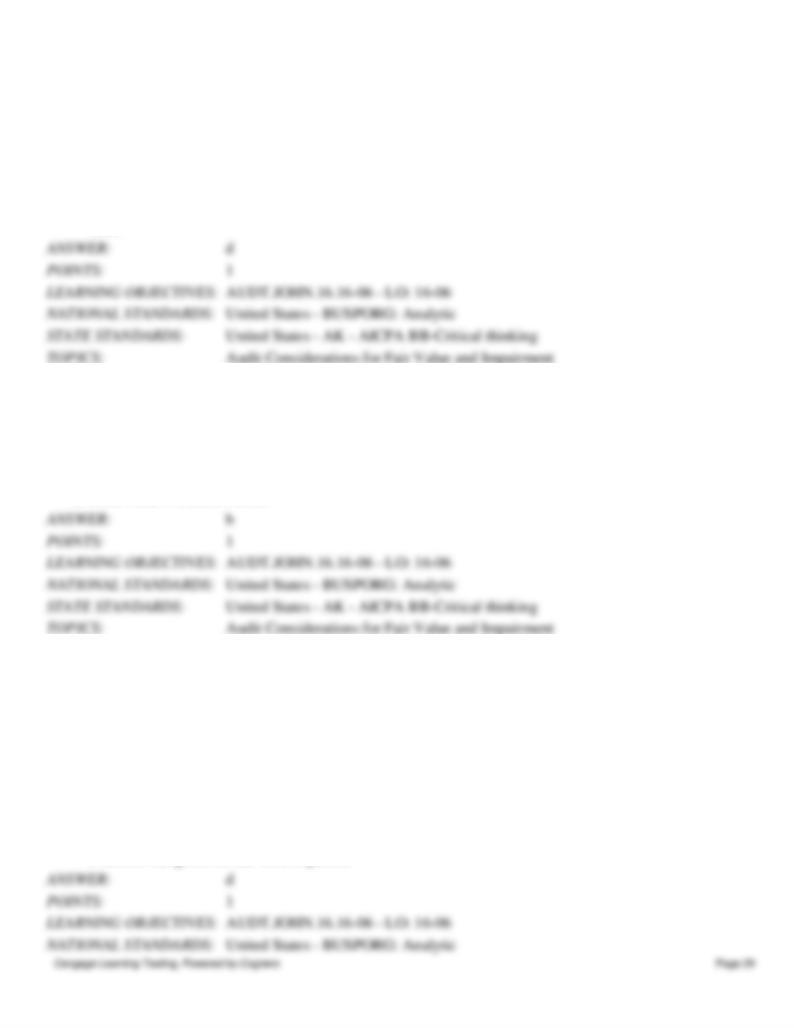
Chapter 16 - Advanced Topics Concerning Complex Auditing Judgments
a.
Goodwill arising from acquisitions can be netted into one test at the operating segment level, but not
netted at the company level.
b.
Market valuation may be volatile. A temporary decline in market value may not be a good indicator
of FMV.
c.
FMV might not exist, might require independent appraisals by investment bankers or estimates using
cash flow and discounted present value factors.
d.
No assumptions are required about competition, economic development, product placement, and so
forth.
103. Impairment is measured by the difference between market value of the operating segment and which of the
following?
a.
Carrying value of net assets.
b.
Fair market value of net assets.
c.
Book value of total assets.
d.
Book value of current assets.
104. In a standard audit program for goodwill impairment testing, if the original reporting unit no longer exists
because operations have been fully integrated into operations of the parent company, which approach should the
auditor take?
a.
Compare market value with carrying value. A market value less than carrying value is presumptive
evidence that goodwill has been impaired.
b.
Compare fair value with realizable value. A fair value less than realizable value is presumptive
evidence that goodwill has been impaired.
c.
Compare book value with realizable value. A book value less than realizable value is presumptive
evidence that goodwill has been impaired.
d.
Compare book value with market value. A market value less than book value is presumptive
evidence that goodwill has been impaired.
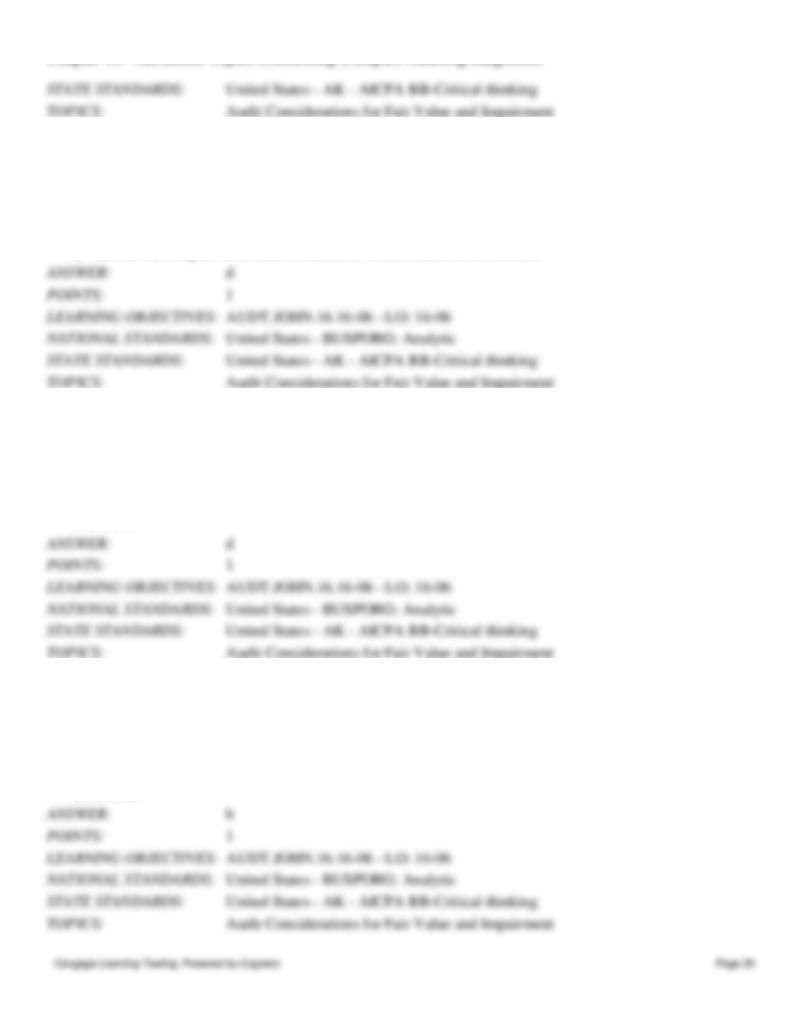
Chapter 16 - Advanced Topics Concerning Complex Auditing Judgments
105. The FASB has set a hierarchy of inputs to consider in assessing fair value. Which of the following relates
to Level 3?
a.
Quoted prices for identical items in active, liquid, and visible markets.
b.
Unobservable inputs to be used in illiquid situations.
c.
Observable information for similar items in active or inactive markets.
d.
Unobservable inputs to be used in situations where markets do not exist.
106. The FASB has set a hierarchy of inputs to consider in assessing fair value. Which of the following
valuations are generally viewed as the most subjective?
a.
Level 0.
b.
Level 1.
c.
Level 2.
d.
Level 3.
107. The FASB has set a hierarchy of inputs to consider in assessing fair value. Price taken from a recent trade
on the NIKKEI of an index stock would fall under which level?
a.
Level 0.
b.
Level 1.
c.
Level 2.
d.
Level 3.

Chapter 16 - Advanced Topics Concerning Complex Auditing Judgments
108. Which of the following models is associated with Level 3 in the FASB hierarchy for ascertaining fair
value?
a.
Mark to market model.
b.
Replacement model.
c.
Mark to model.
d.
Historical cost model.
109. Under which of the following approaches is the client expected to estimate fair value based on a model of
the future cash flows associated with the instrument or the asset?
a.
Mark to market model.
b.
Replacement model.
c.
Mark to model.
d.
Historical cost model.
110. Which one of the following general factors would not be considered when assessing identified internal
control deficiencies?
a.
Control environment.
b.
Audit evidence from a poorly controlled system.
c.
Repeatability of a process.
d.
Complexity and subjectivity of the account balance affected by the deficiency.
111. Material misstatements in the financial statements, including those requiring restatements strongly imply a
material weakness in which of the following?
a.
Income statement.
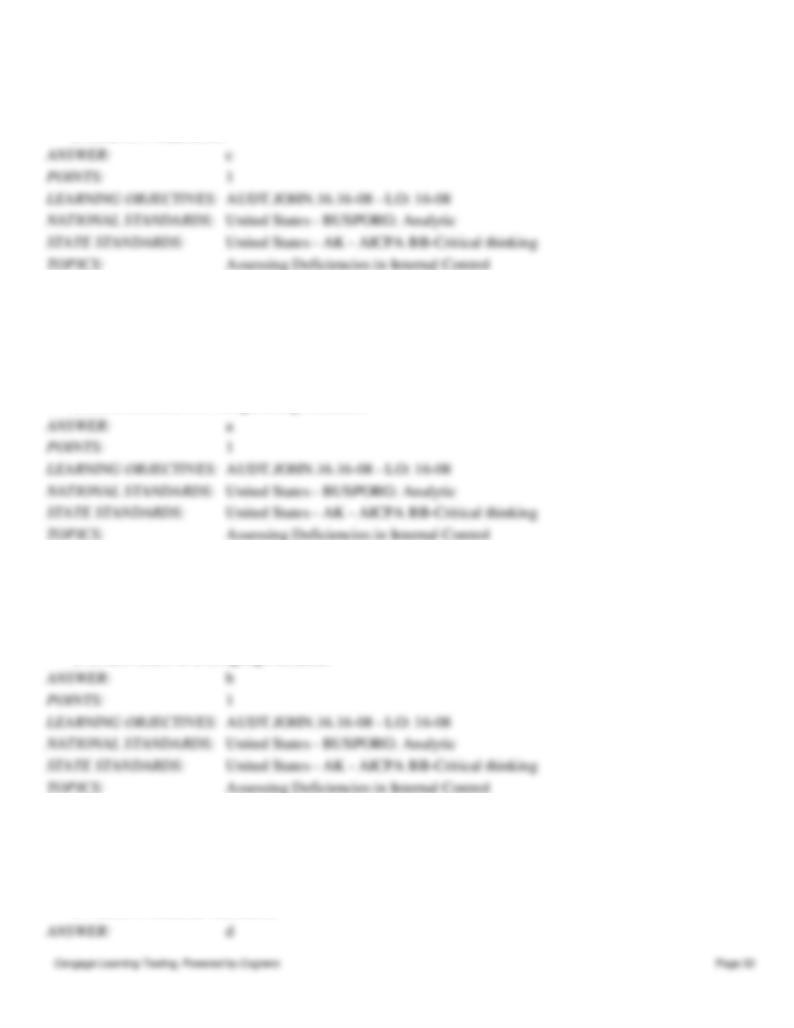
Chapter 16 - Advanced Topics Concerning Complex Auditing Judgments
b.
Balance sheet.
c.
Internal control over financial reporting.
d.
Cash flow statements.
112. Which of the following factors can mitigate concerns that the auditor might otherwise have about a
material weakness that was identified at an interim date?
a.
Remediation of the control deficiency after the interim date.
b.
Existence of a compensating control at the year-end date that was also present at the interim date.
c.
Weaknesses in the control environment.
d.
Ineffectiveness of oversight and governance.
113. Which of the following factors is not relevant when assessing identified internal control deficiencies?
a.
Weaknesses in the control environment.
b.
The absence of a material misstatement in the financial statements.
c.
Volume of transactions affected by the deficiency.
d.
Effectiveness of oversight/governance.
114. Which of the following reflects the scope of services performed in external auditing by a CPA?
a.
Risk analysis.
b.
Control analysis.
c.
Operations analysis.
d.
Audits of financial statements.
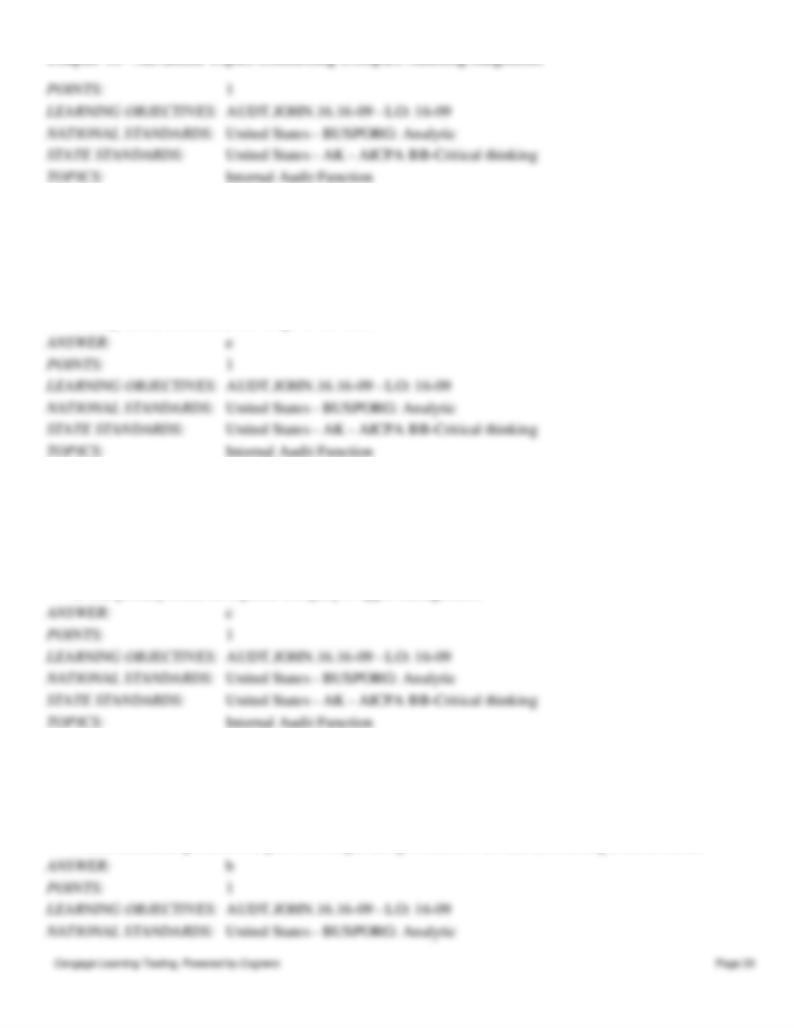
Chapter 16 - Advanced Topics Concerning Complex Auditing Judgments
115. Which of the following is not included in the scope of services performed in internal auditing by a CIA?
a.
Assurance and consulting.
b.
Operations analysis.
c.
Operational efficiency reviews.
d.
Internal control analysis.
e.
They are all included in the scope of services.
116. Which of the following statements is true of external auditing?
a.
Major focus areas are processes, including risks, controls, and effectiveness and efficiency of
processes.
b.
External auditors perform both assurance and consulting services for public companies.
c.
Primary scope of services performed includes audits of financial statements.
d.
The primary client for a public company is upper management.
117. Which of the following statements is true of internal auditing?
a.
The primary client is the investor in the company.
b.
The primary nature of services include assurance and consulting.
c.
The parties receiving assurance are regulatory agencies and stockholders.
d.
Internal auditing must be responsible for gathering evidence in all audits, including external audits.
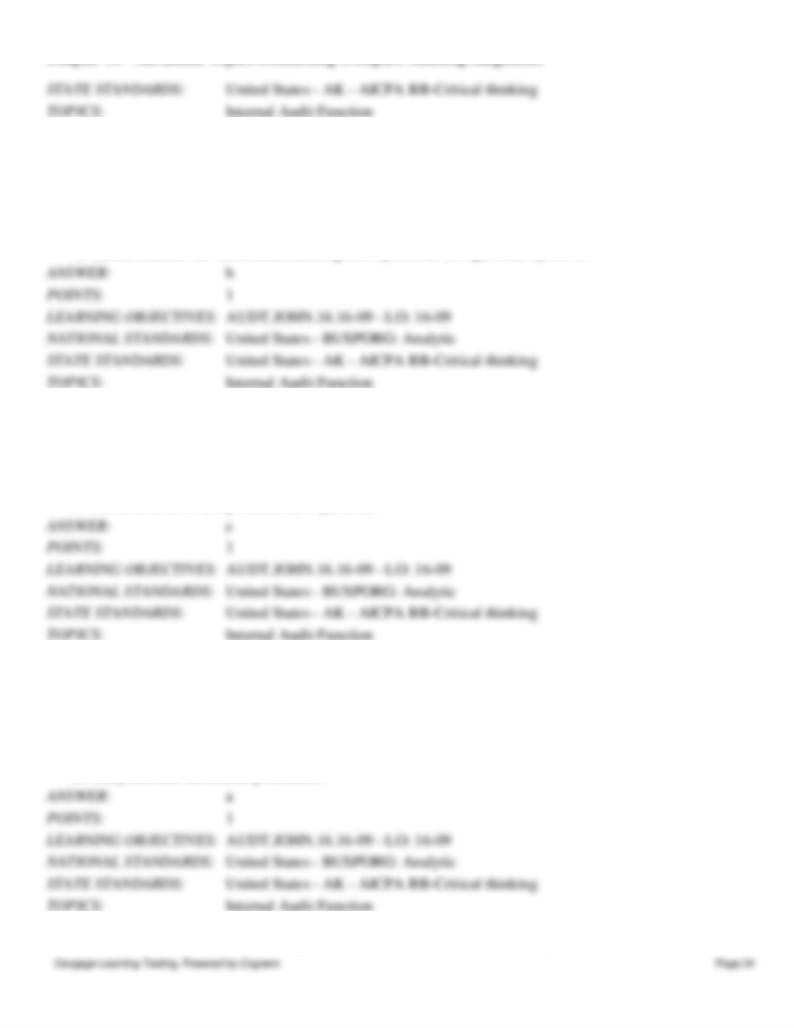
Chapter 16 - Advanced Topics Concerning Complex Auditing Judgments
118. Which of the following is the IIA’s stated position regarding the internal auditing activity?
a.
All responsibilities for internal auditing activity can be outsourced.
b.
An in-house liaison, such as an executive or senior management member, should be assigned the
responsibility for internally managing the internal auditing activity.
c.
All internal auditors involved in the internal auditing activity must be CIAs.
d.
Internal auditors for the internal auditing activity should be supervised by CPAs.
119. Which of the following factors is not considered in assessing the quality of the internal audit?
a.
Quality of working-paper documentation, reports, and recommendations.
b.
Review of quality of audit policies, programs, and procedures.
c.
Attestation services as demanded by market place.
d.
Educational level and professional experience.
120. The partial or complete outsourcing of internal audit activities is most likely made to public accounting
firms or to other specialized firms who perform which of the following?
a.
Primarily risk, control, and audit activities.
b.
Attestation services as demanded by market place.
c.
Operations analysis and risk analysis.
d.
Analytical and substantial procedures.
121. A best practice is to have an oversight of the internal audit function as a responsibility of which of the
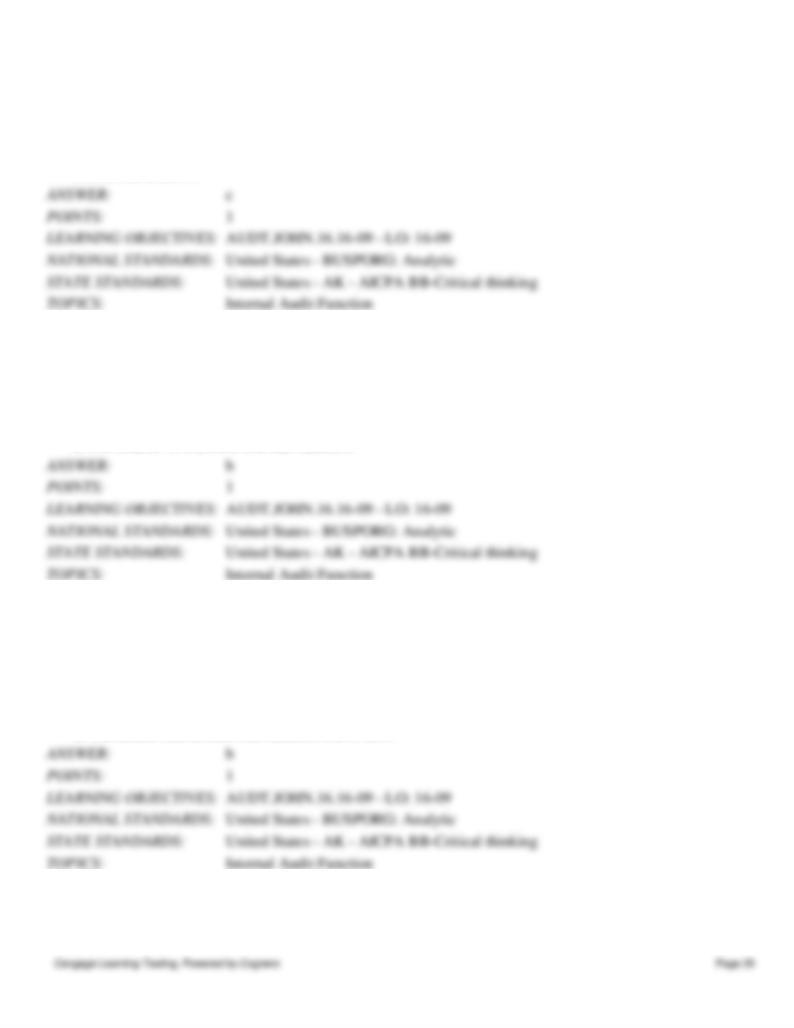
Chapter 16 - Advanced Topics Concerning Complex Auditing Judgments
following?
a.
Management.
b.
Internal auditors.
c.
Audit committee.
d.
External auditors.
122. Which of the following is the international body that sets standards for the practice of internal auditing
across the world?
a.
The Internal Audit Reporting Standards Board.
b.
The Institute of Internal Auditors.
c.
The International Accounting Standards Board.
d.
The Charter of Certified Internal Auditors.
123. Assume that the external auditor decides that because of work performed by internal auditors, the audit risk
has been reduced to an acceptable level. As a result of this assessment, the auditor can do which of the
following?
a.
The auditor must test the assertions directly and document a separate conclusion.
b.
The auditor can decide that direct testing is not necessary.
c.
The auditor must delegate the responsibility of expressing an opinion to the internal auditors.
d.
The auditor can assume that inherent risk is zero.
124. In making judgments about the effect of the internal auditors’ work on the external auditor’s procedures in
specific audit areas, which of the following is not one of the issues related to the specific audit areas that is
considered by the external auditor?
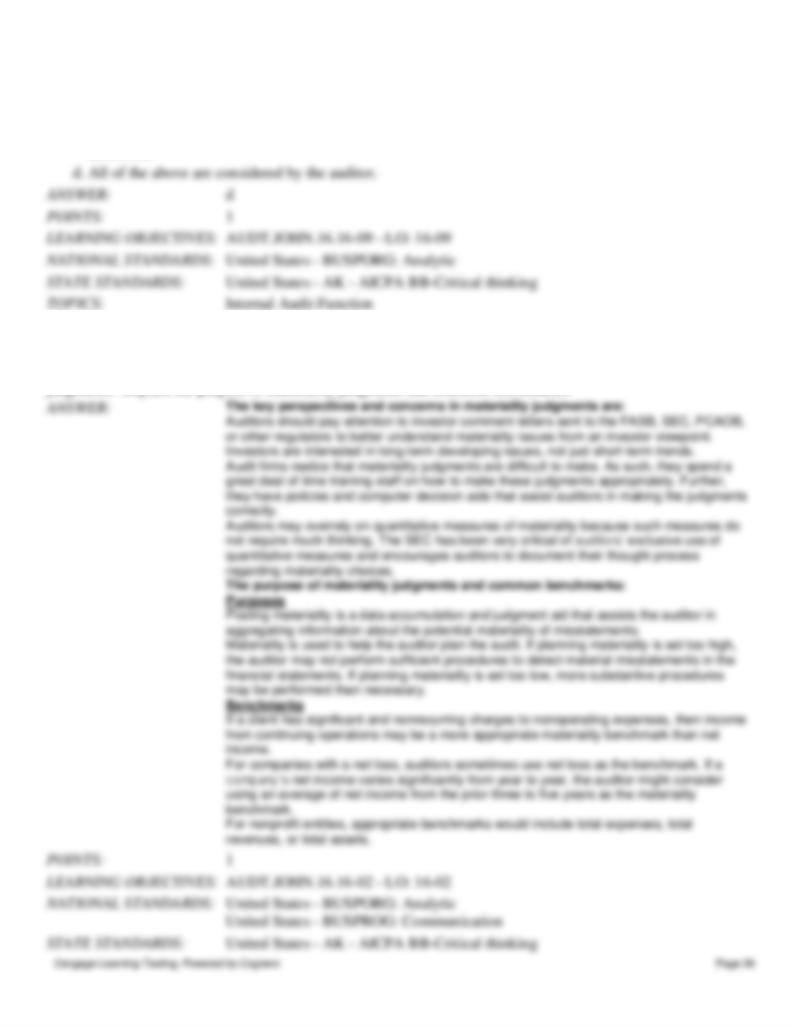
Chapter 16 - Advanced Topics Concerning Complex Auditing Judgments
a.
Materiality of the financial statement amounts.
b.
Risk of material misstatement of the assertions related to these financial statement amounts.
c.
Degree of subjectivity involved in the evaluation of the audit evidence gathered in support of the
assertions.
125. Purpose of Materiality Judgments and Common Benchmarks
What are the key perspectives and concerns that auditors should be aware of when making materiality
judgments? Explain the purpose of materiality judgments and common benchmarks.
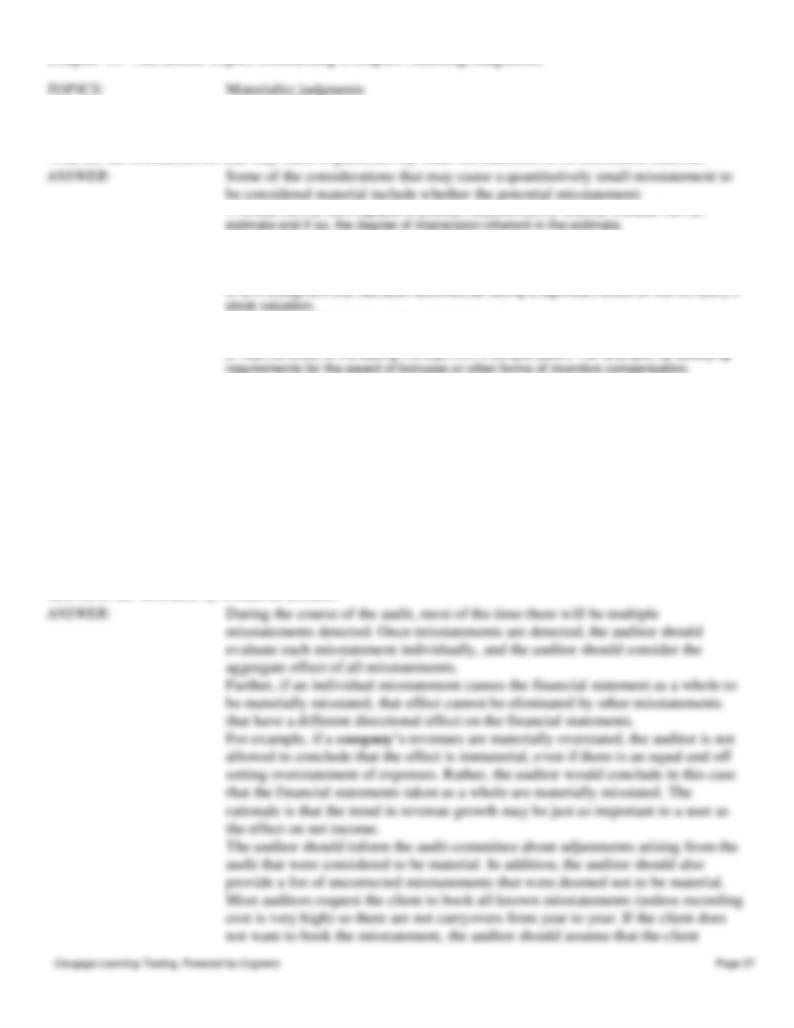
Chapter 16 - Advanced Topics Concerning Complex Auditing Judgments
126. Considering Qualitative Factors
What are the considerations that may cause a quantitatively small misstatement to be considered material?
2. Masks a change in earnings or other trends.
3. Hides a failure to meet analysts’ consensus expectations for the enterprise.
4. Changes a loss into income or vice versa.
6. Affects compliance with regulatory requirements.
7. Affects loan covenants or other contractual requirements.
9. Involves concealment of an unlawful transaction.
POINTS:
1
LEARNING OBJECTIVES:
AUDT.JOHN.16.16-02 - LO: 16-02
NATIONAL STANDARDS:
United States - BUSPORG: Analytic
United States - BUSPROG: Communication
STATE STANDARDS:
United States - AK - AICPA BB-Critical thinking
TOPICS:
Materiality judgments
127. Assessing Whether Misstatements Are Material
What additional information might the auditor choose to analyze to determine whether or not the financial
statements are misstated by a material amount?
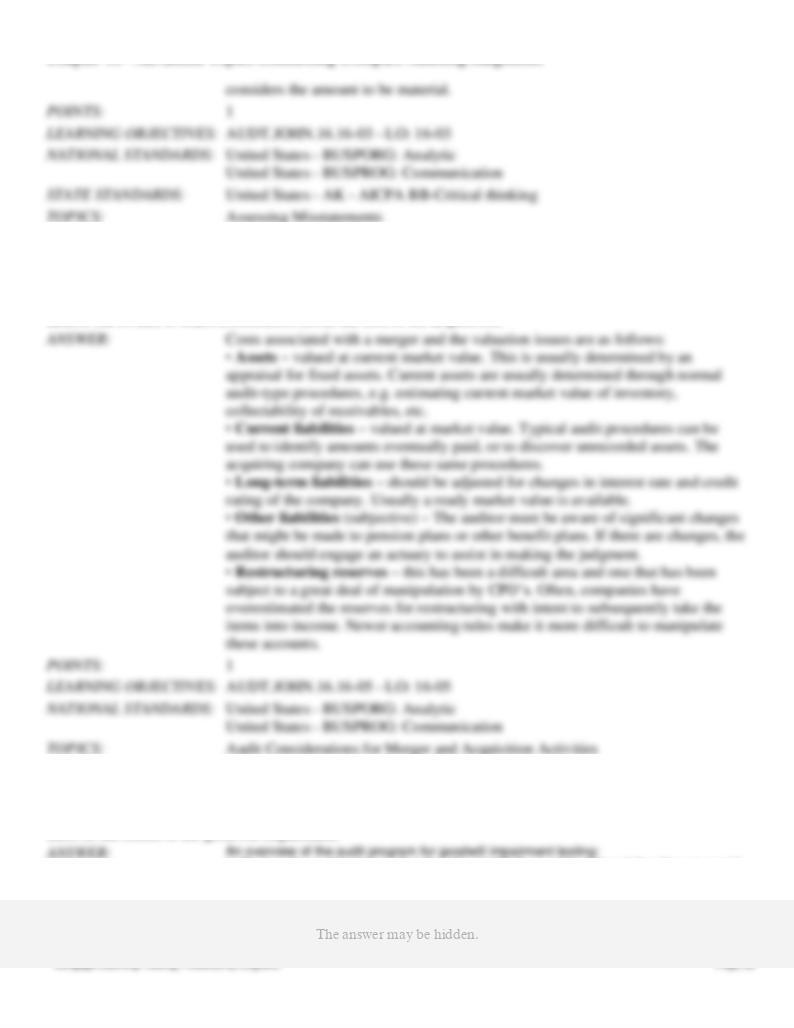
Chapter 16 - Advanced Topics Concerning Complex Auditing Judgments
128. Auditing Merger and Acquisition Transactions
How does a company measure the cost of an acquisition of another company? What factors often complicate the
determination of actual cost? Explain how each factor complicates the calculation of cost and the steps the
auditor has to take to reach a conclusion about the cost of the acquisition.
129. Audit Program for Goodwill Impairment Testing
Outline the major elements of an audit program to determine whether there is a goodwill impairment, and if
there is, the extent of the goodwill impairment.
1. Review the methodology that the client initially used in determining the amount it
used to purchase the reporting unit. Examine the initial client documents to
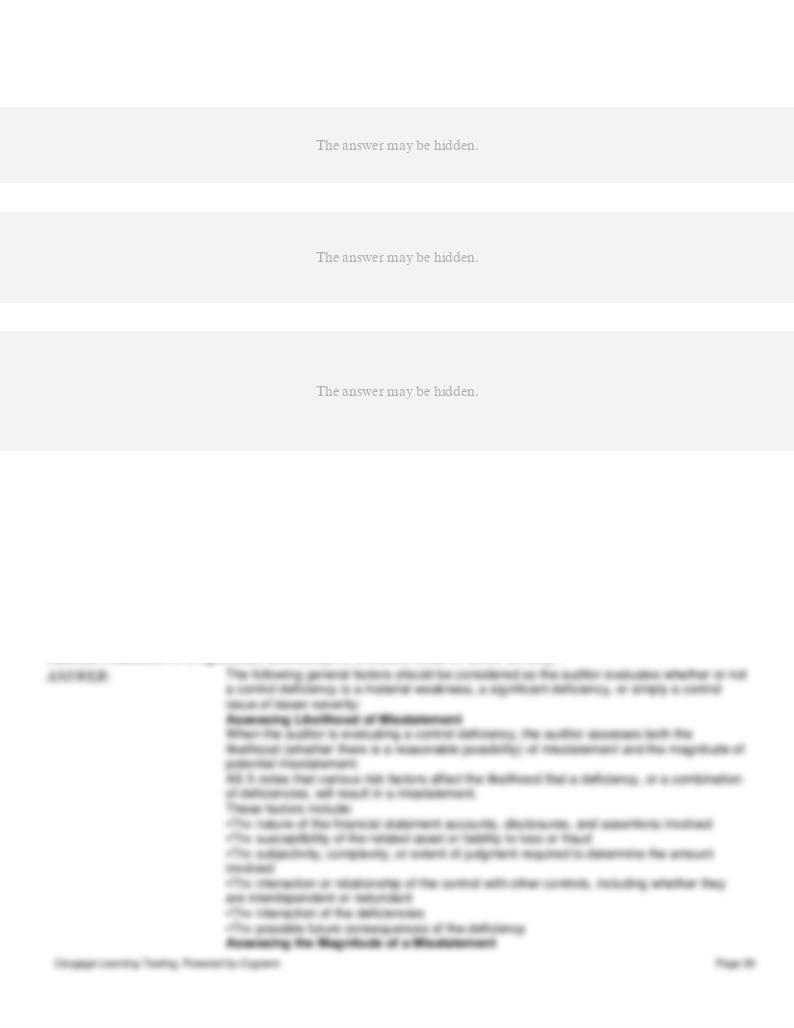
Chapter 16 - Advanced Topics Concerning Complex Auditing Judgments
d. Assumptions about the general economy, industry growth, and new-product innovation.
3. If the client does not have the original data, perform an independent analysis of
4. If the original reporting unit no longer exists because operations have been fully
POINTS:
1
LEARNING OBJECTIVES:
AUDT.JOHN.16.16-06 - LO: 16-06
NATIONAL STANDARDS:
United States - BUSPORG: Analytic
United States - BUSPROG: Communication
STATE STANDARDS:
United States - AK - AICPA BB-Critical thinking
TOPICS:
Audit Considerations for Fair Value and Impairment
130. Critical Criteria in Assessing Identified Internal Control Deficiencies
What general factors should be considered by an auditor in evaluating whether or not a control deficiency is a
material weakness, or a significant deficiency, or a control issue of lesser severity?
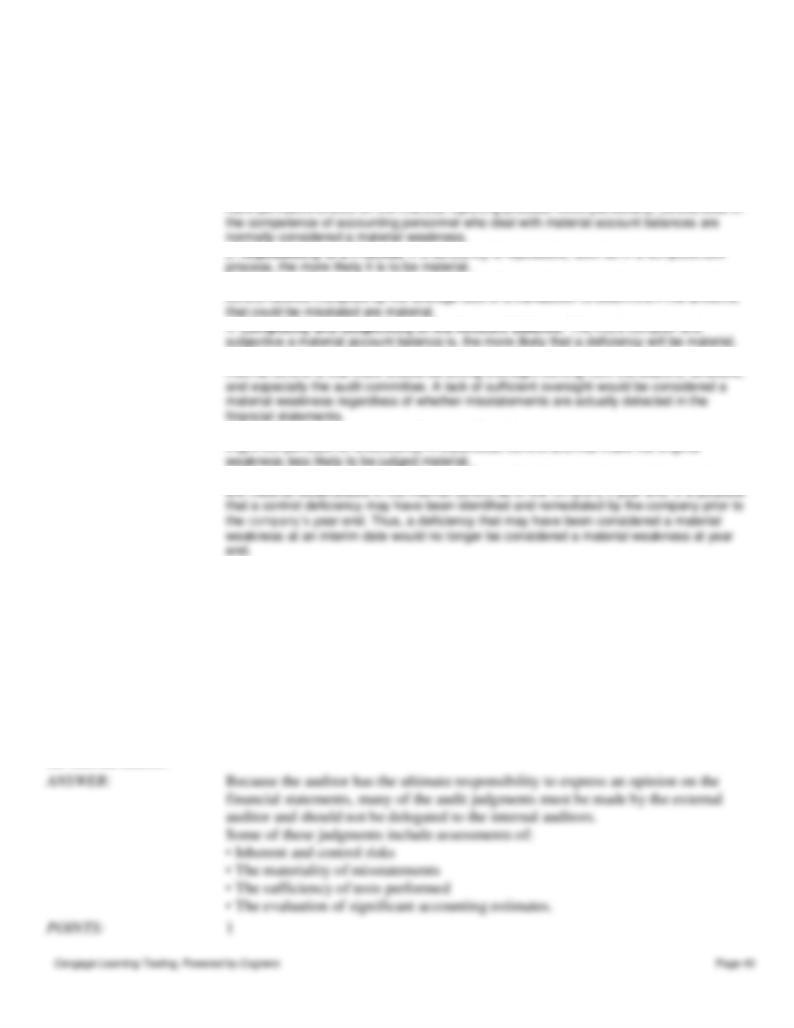
Chapter 16 - Advanced Topics Concerning Complex Auditing Judgments
AS 5 also identifies factors affecting the magnitude of the misstatement that might result
from a deficiency, including:
•The financial statement amounts or total of transactions exposed to the deficiency
•The volume of activity in the account balance or class of transactions exposed to the
deficiency that has occurred in the current period or that is expected in future periods.
Other Factors
Other factors to consider when assessing a control deficiency include:
1. Control Environment. Weaknesses in specific components of the control environment
3. Volume of Transactions Affected. The auditor needs to assess the percentage of
5. Effectiveness of Oversight and Governance. One of the key elements of good
6. Existence of Compensating Controls. Often there are other controls in place that
7. Remediation of a Control Deficiency. The auditor’s report addresses whether there
POINTS:
1
LEARNING OBJECTIVES:
AUDT.JOHN.16.16-08 - LO: 16-08
NATIONAL STANDARDS:
United States - BUSPORG: Analytic
United States - BUSPROG: Communication
STATE STANDARDS:
United States - AK - AICPA BB-Critical thinking
TOPICS:
Assessing Deficiencies in Internal Control
131. Effect of Internal Audit’s Work on the External Audit
Provide examples of audit judgments made by the external auditor which would not typically be delegated to
the internal auditor.
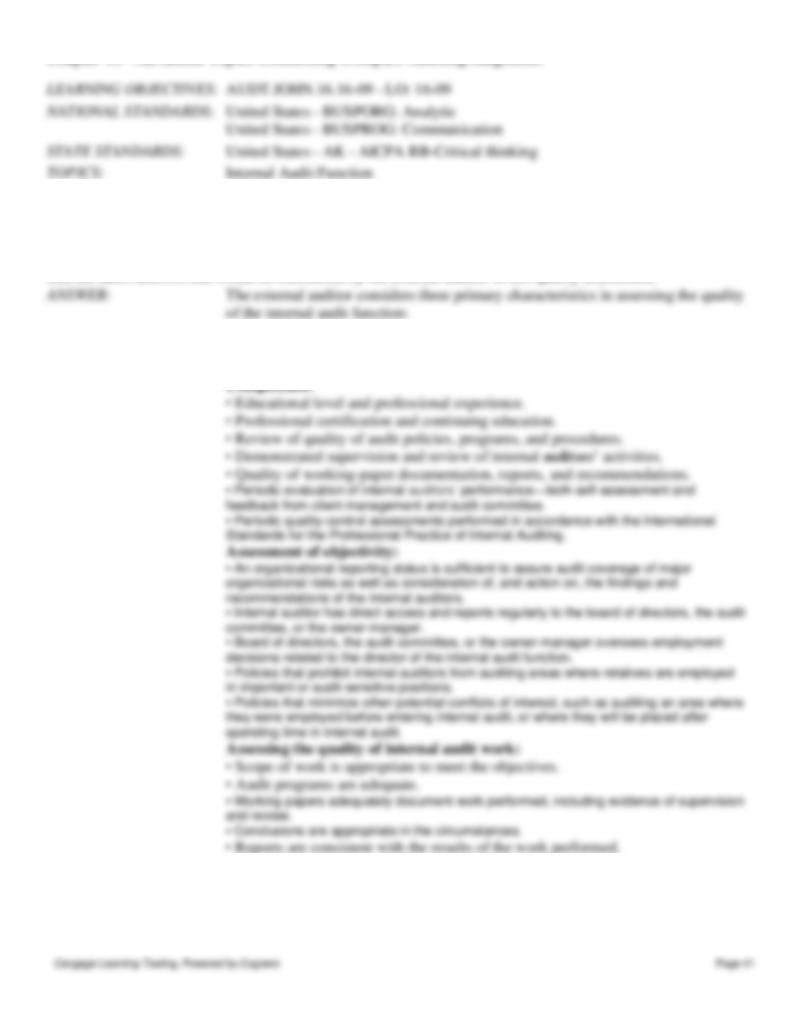
Chapter 16 - Advanced Topics Concerning Complex Auditing Judgments
132. Evaluating the Quality of Client’s Internal Audit Function
An external auditor assesses the quality of the internal audit function to determine whether the internal auditors’
work is relevant to the external audit and of sufficient quantity and quality. Describe the three factors of the
internal audit function that would be considered by the external auditor in this quality assessment.
1. Competence,
2. Objectivity, and
3. Quality of work performance.
POINTS:
1
LEARNING OBJECTIVES:
AUDT.JOHN.16.16-09 - LO: 16-09
NATIONAL STANDARDS:
United States - BUSPORG: Analytic
United States - BUSPROG: Communication

Chapter 16 - Advanced Topics Concerning Complex Auditing Judgments
STATE STANDARDS:
United States - AK - AICPA BB-Critical thinking
TOPICS:
Internal Audit Function